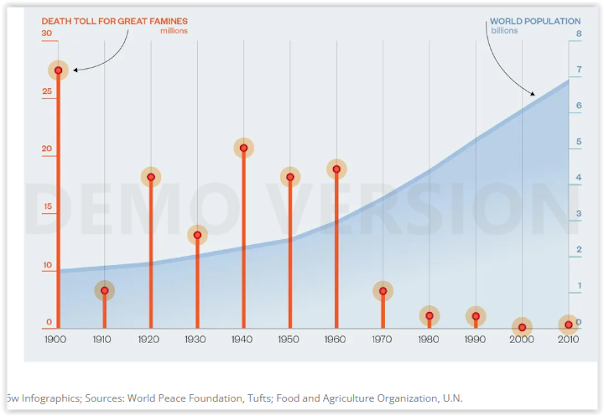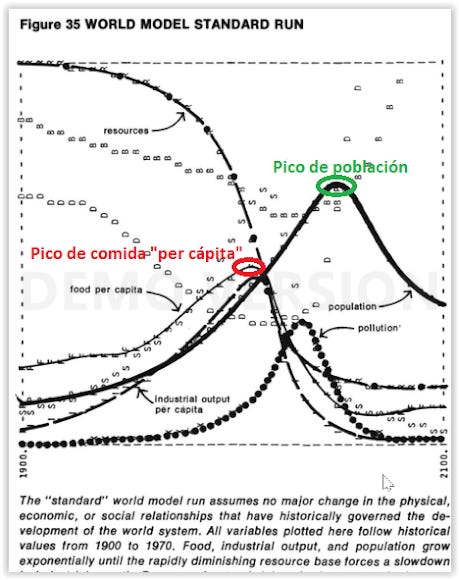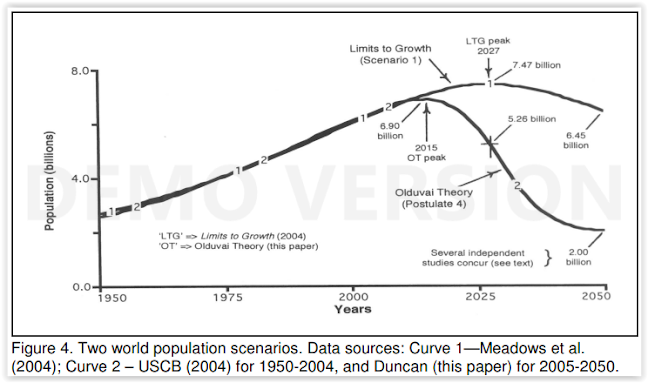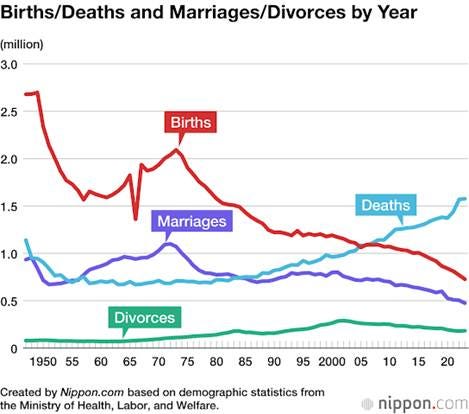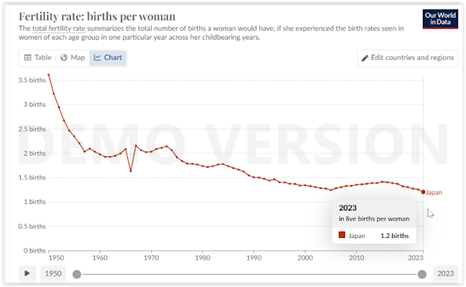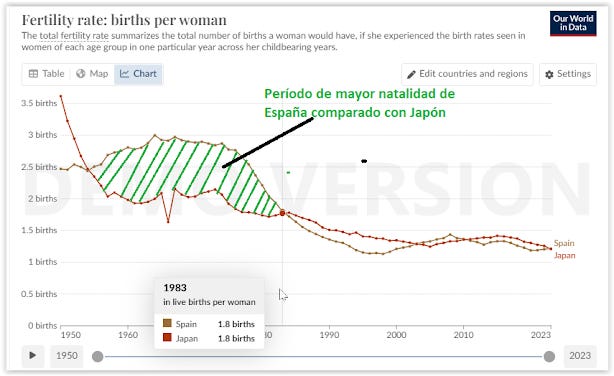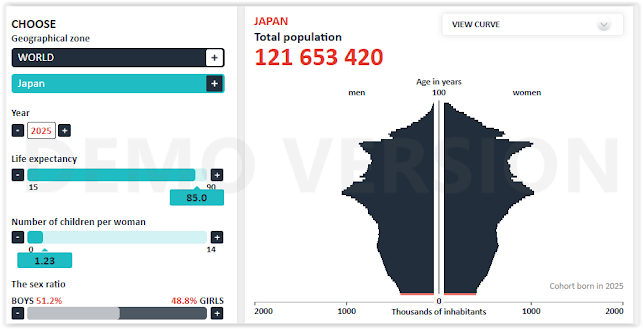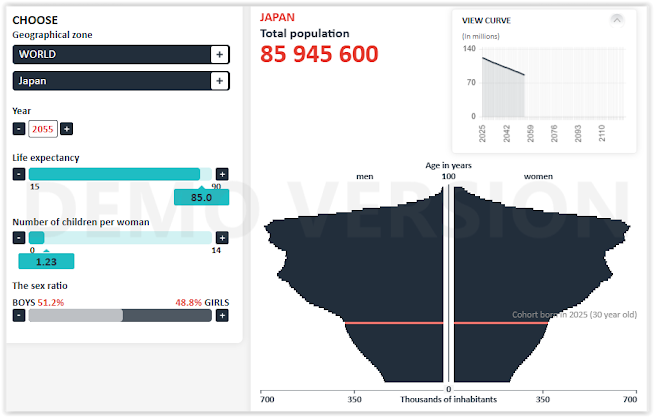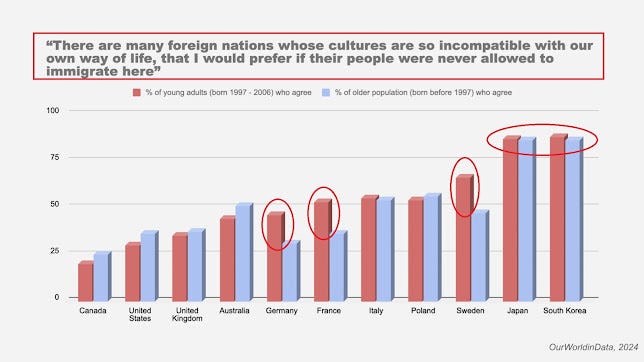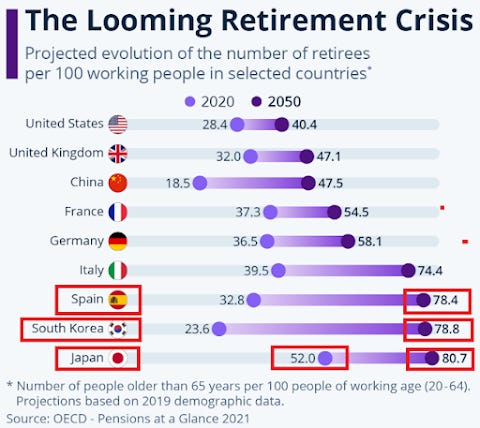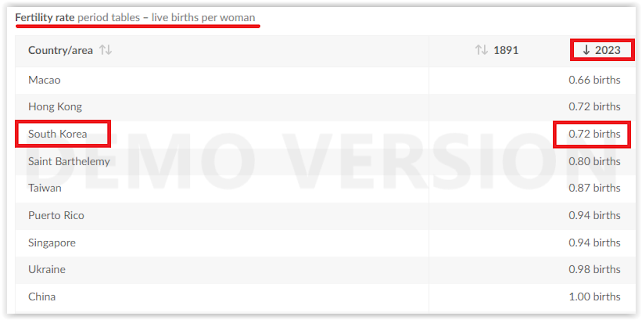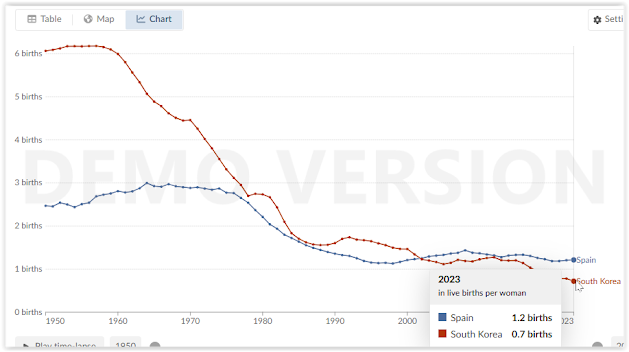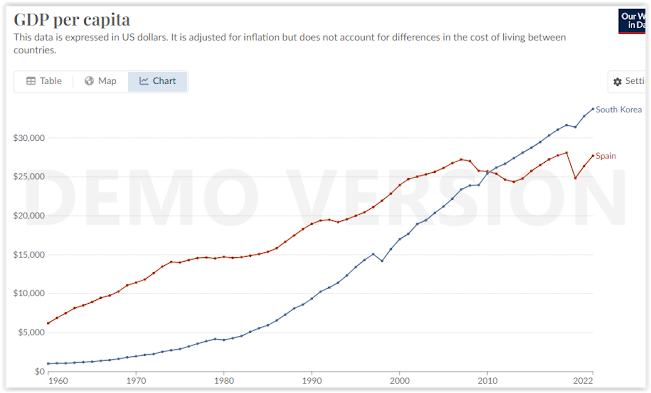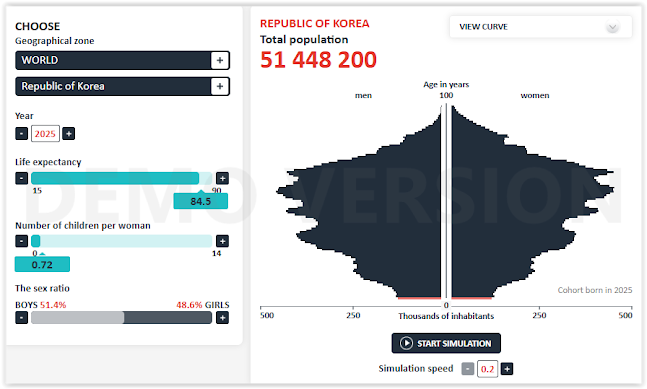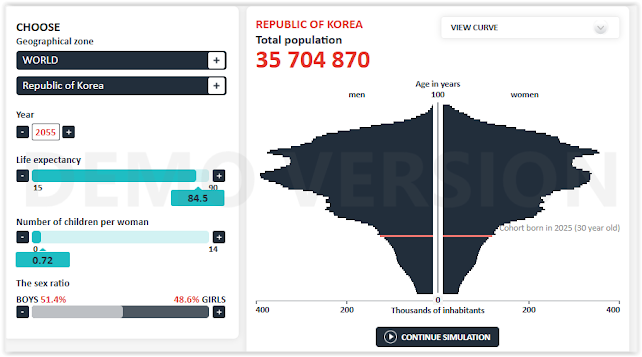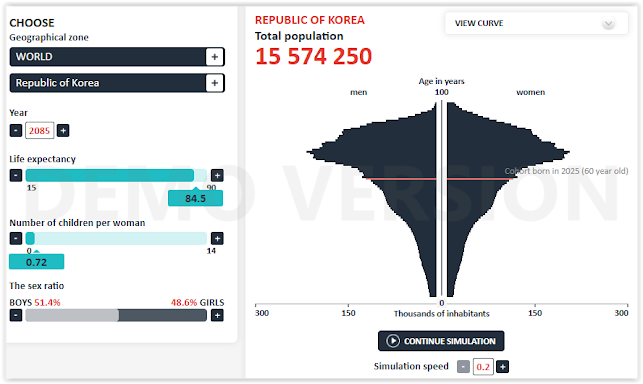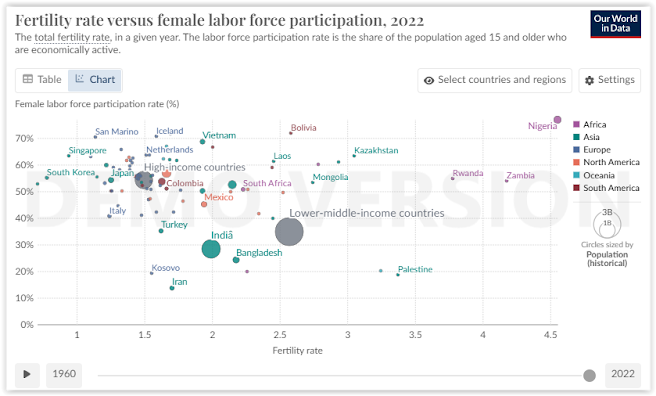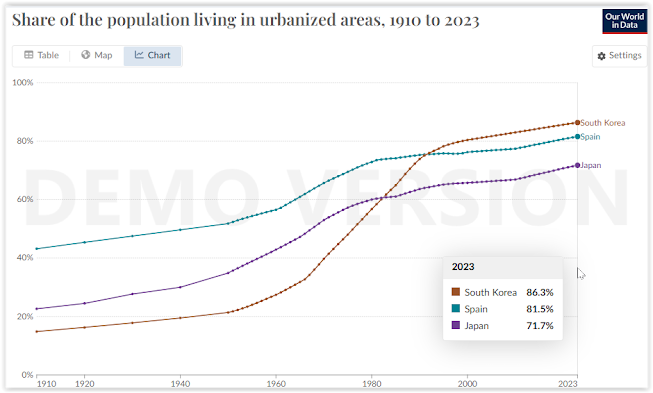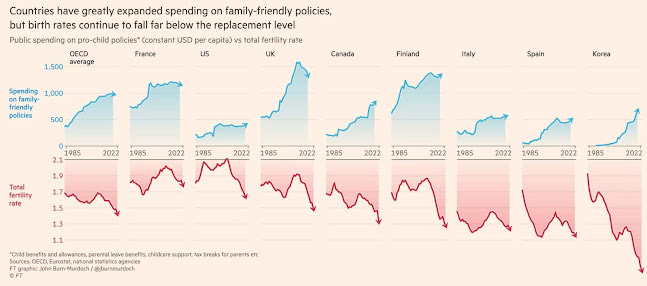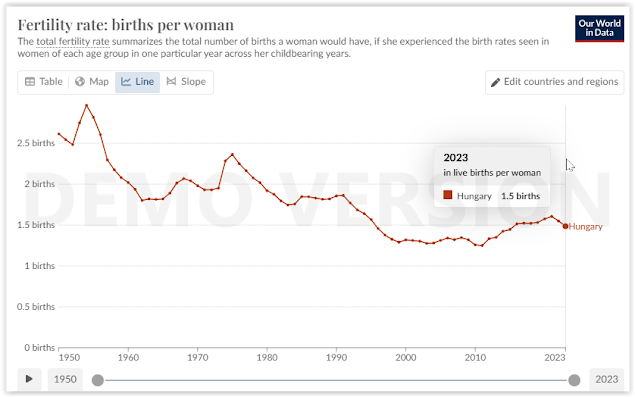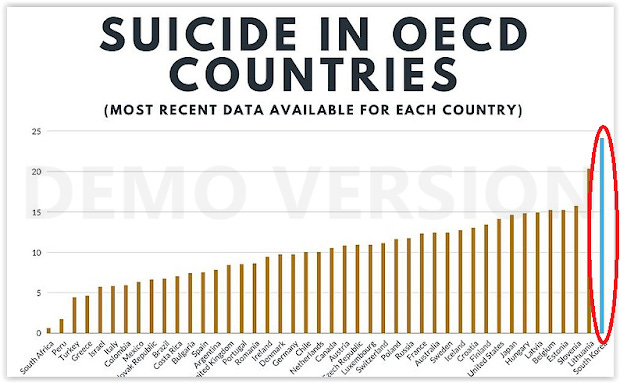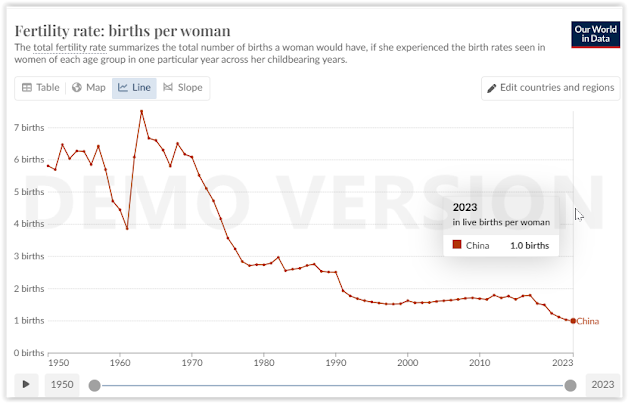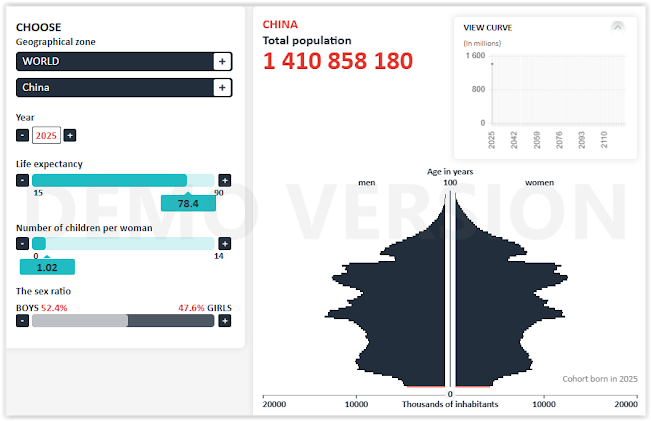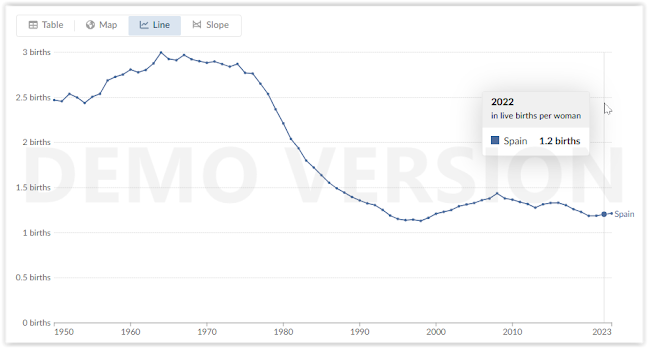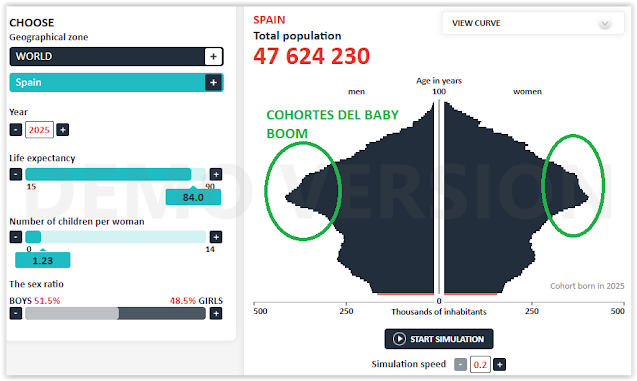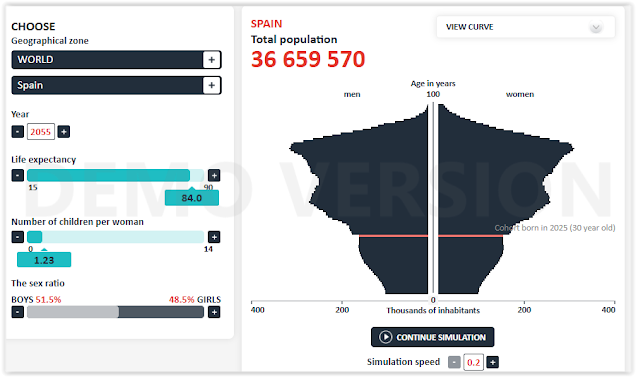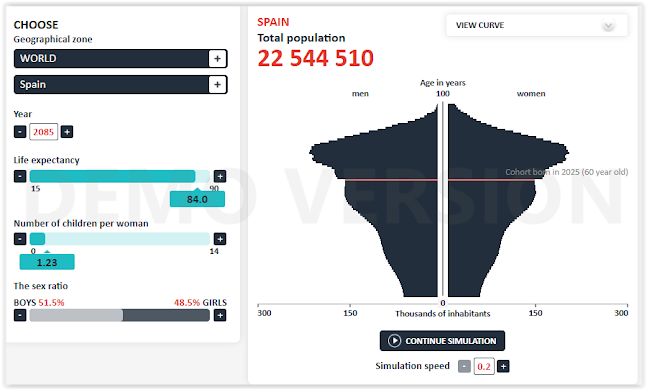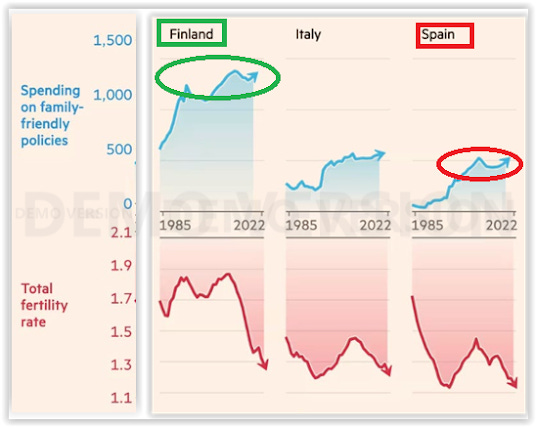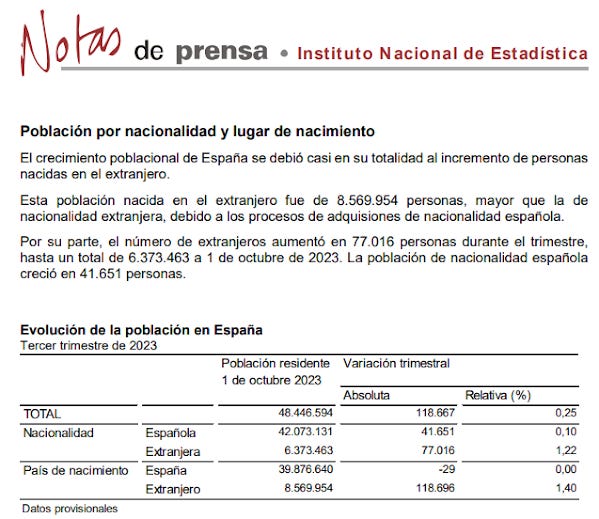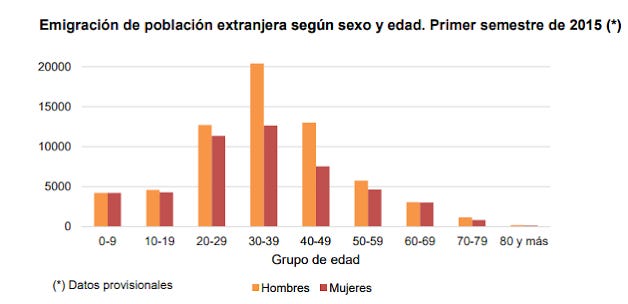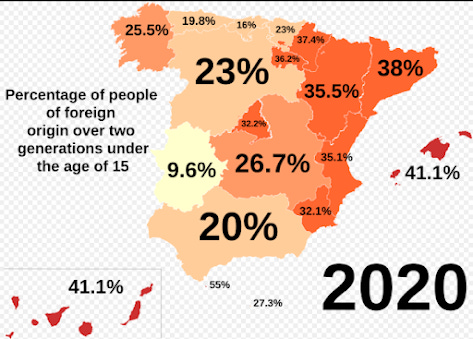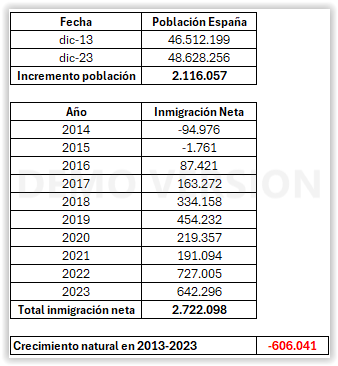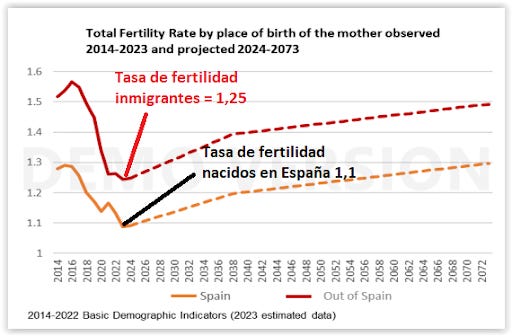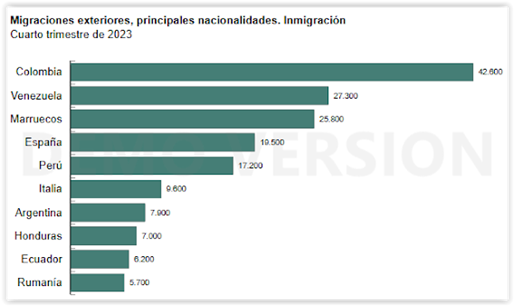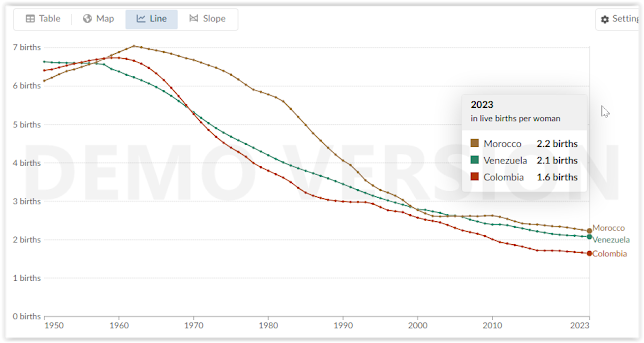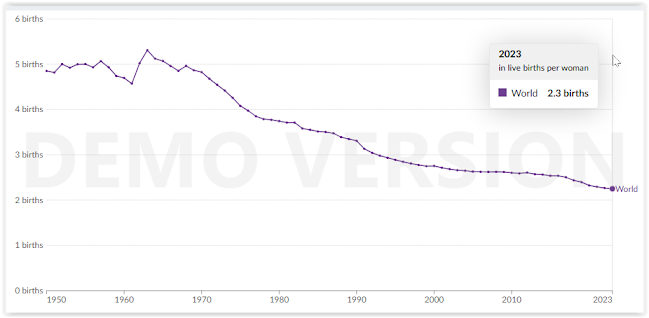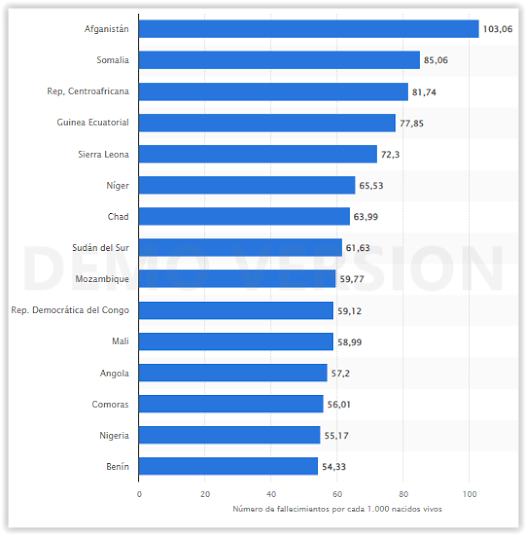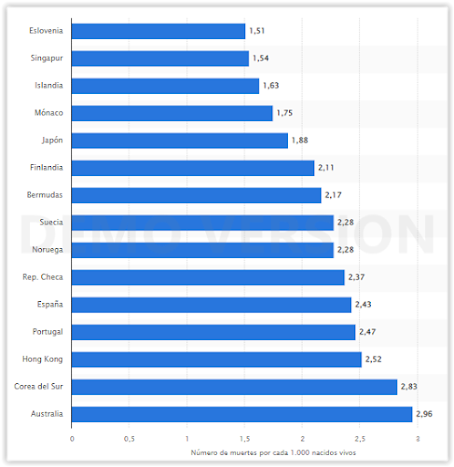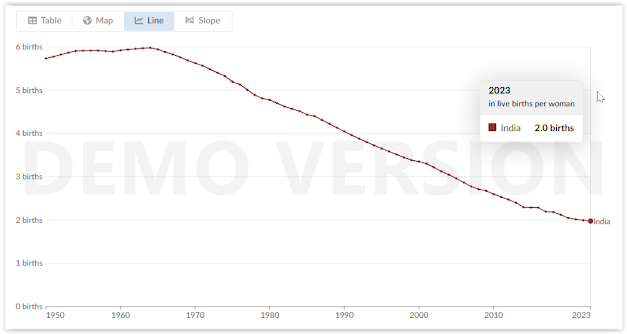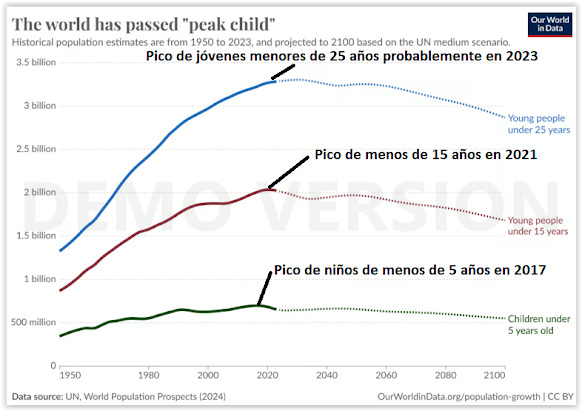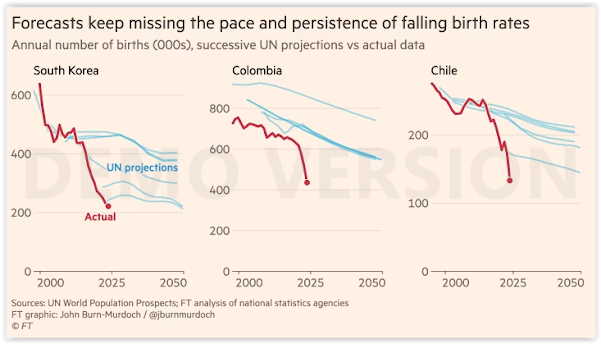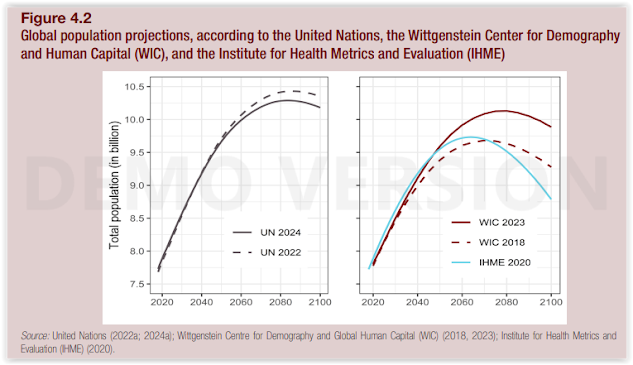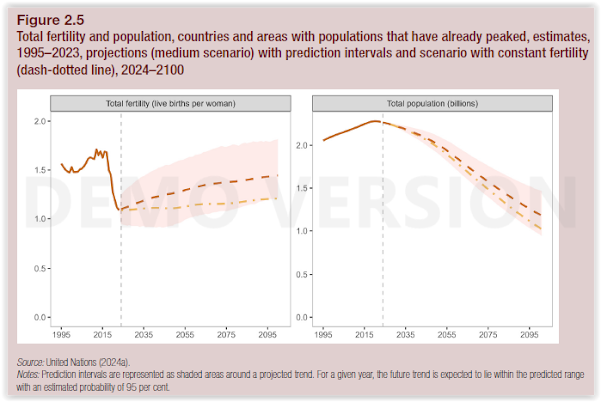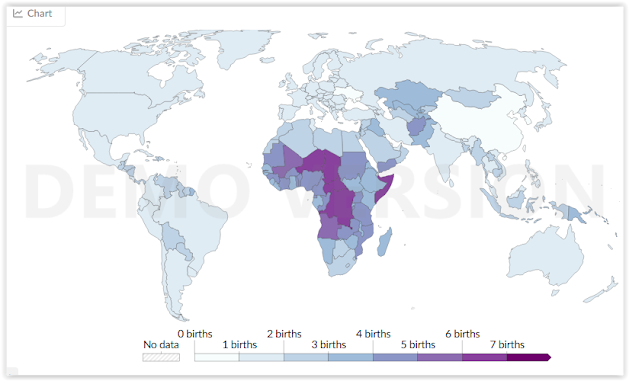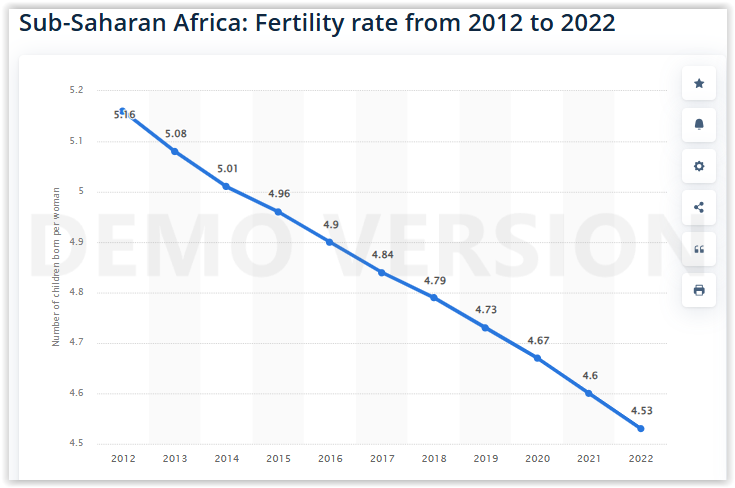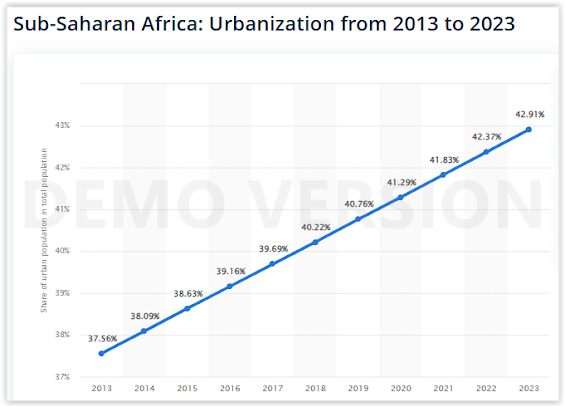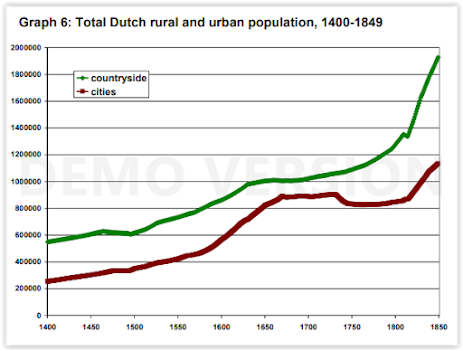Demographic Collapse and Civilization
INTRODUCTION
In the 1960s and 1970s of the past century, it was widely believed that global overpopulation would be a serious problem even before the end of the 20th century, or at the latest in the first decades of the 21st, and would eventually affect even the most developed countries. And in the studies I know from that time, in estimates of the sustainability of civilization, or even in science fiction, it was assumed that population growth, both within individual countries and globally, would only be halted by a massive mortality rate, primarily due to resource scarcity combined with environmental damages (which ultimately led to resource scarcity) and ultimately massive famine. In any case, none of the estimates I've read about the evolution of our civilization from that time considered the possibility that the population might ultimately decline by people's own volition. Well I'm lying, a theory, quite older, did have this as a fundamental thesis and it is the one that appears in the book " The Decline of the West " by Oswald Spengler , who published it in 1918 no more and no less (although in the prologue he states that the book was almost finished before the start of World War I in 1914), a time when population growth in all European countries was even faster than in the 60s or 70s (fertility rates of 4 - 6 children per woman were usual), and which I will talk about in more detail at the end of this section.
Perhaps the book that most emphasized at the time (1960s) the urgent problem of depopulation and famine, which "in a few decades" would wipe out hundreds of millions of people, also in developed countries, was the famous book by Stanford University biologist Paul Ehrlich " The Population Explosion " (1968), originally titled in English " The Population Bomb ", and its conclusions include:
"The battle to feed humanity is over. In the 1970s, hundreds of millions of people will die of starvation despite any food aid program." that we embark on from now on . At this late date, nothing can prevent a substantial increase in the mortality rate worldwide."
Which, as we know, was not the case by any stretch of the imagination. On the other hand, in the first edition of "Earth Day" in 1970, in the magazine " The Progressive " Paul Ehrlich wrote:
" By 1989, some four billion people, including 65 million Americans, would perish in the “Great Die-Off.”
In the Mademoiselle magazine, Paul Ehrlich stated:
“The death rate will increase until at least 100 to 200 million people will die of starvation each year for the next ten years [by 1980].”
And also in the same interview he said;
" The population will inevitably completely outstrip any small increase we make in the food supply ."
Of course, as we all know, there was no major famine in the US before 1980 that killed 65 million Americans; on the contrary, what happened was an extreme rise in obesity in that country. Of course, the second statement was also completely wrong, and we all know that 4 billion people did not die of famine in the 1970s, before 1980.
What actually happened with the world's great famines was this :
As can be seen, there was, in fact, a drastic decrease in famines, both in absolute terms and relative to the population, as the successive decades passed.
Another book from that period that served as inspiration to Paul Ehrlich was the one published in 1967 by William and Paul Paddock , entitled " Famine, 1975! " (" Famine , 1975 ! "), whose title reminds me of the Hollywood disaster movies that were popular at that time, such as " Airport 75 " and others.
The fundamental theses of this book are:
1) Underdeveloped nations have expanding populations and static agriculture.
2) The "famine era" will become apparent in 1975, when food crises will have occurred in several of these nations.
3) "The affected peoples will not be able to pay for all the food imports they need. Therefore, hunger in these regions can only be alleviated through charity from other nations" (page 205).
4) The only major food to alleviate famine will be wheat, and only the United States, Canada, Australia and Argentina grow significant amounts of wheat.
5) The United States is the only one of these four countries that has historically given wheat to starving nations, it is the "only hope of starving nations" in the future (page 206)
6) "Yet America, even if it fully cultivates all its land, even if it opens all the taps of charity, will not have enough wheat and other foodstuffs to keep all the hungry alive" (page 206)
7)"Therefore, the United States must decide which countries it will send food to and which ones it will not ."
For all these reasons, it is argued in this book, the US should implement a " triage " system of poor nations (like the one doctors were forced to apply in the Covid pandemic when hospital services were unfortunately overwhelmed) and decide which countries will receive aid and which will be left "to their fate", since due to the overpopulation and political ineptitude of these countries (in forcing a stop to population growth) it would be a "waste of resources" any help (as the Malthusian British imperial government of the Irish or the Indians of India thought, because those catholic Irish and the Indians "reproduced like rabbits" so it would be useless at the end to help them) and therefore any help will only delay, for a while, the inevitable mortality and in the end will increase the number of people who will perish and therefore, so making a "rational" calculation, giving them more food will only increase the total net volume of suffering ... This is the main "ethical" foundation of the Malthusian reasons for not helping the poors who have historically used the imperial elites (mainly predestinationists elites ) of certain countries.
Everyone, including the scientific community of those years, was pretty sure that this would be what would happen, and for example in the famous Club of Rome report The Limits to Growth " (1972) written by a group of researchers from MIT (" Massachusetts Institute of Technology ") headed by Donella and Dennis Meadows, and which contains a very extraordinarily accurate and useful warning about the unsustainability of our way of life (which assumes infinite growth), but this study falls into the same assumptions as the rest of the studies and essays of the time, that is, that the population will only decrease due to large mortality rates (mainly due to famine) and it was not contemplated that a strong voluntary reduction in the birth rate could occur; if anything, a strong intervention by governments to lower fertility rates was contemplated as a somewhat remote possibility; as was made, with varying success, by, for example, China and India; although most countries would do nothing.
Limits to Growth report consists of a series of computer simulations of the expected future trajectory of the world as a whole with respect to: population, food production, industrial production, available natural resources, pollution, etc., in order to analyze the expected future trajectory of all societies around the world in various scenarios.
For example, in the so-called " Standard Run", which assumes that "we do nothing" and is sometimes also called BAU (" Business As Usual ") : continuing to do the same thing as we have been doing until now), these researchers obtained the following graph:
According to this simulation, as can be seen, the population followed an exponential evolution with a trend (exponential growth coefficient) similar to that of the world in 1972, until the beginning of the 21st century (around the year 2000) when the peak of food production "per capita" would occur, followed by a very rapid fall in food production due, in turn, to a large drop in the availability of resources; and even so the population continued to grow at practically the same rate until a few decades later when there would be an equally accelerated fall in population due, obviously, to a great famine since at the time of the "peak" population the food "per capita" would be at a very low value, almost zero.
That is, literally, people continue to reproduce without restraint until there is practically nothing to eat and then the Great Famine occurs...
Of course, I am not criticizing or diminishing the immense merit of this study, which was the first to use a systemic perspective to expose the impossibility of maintaining the existing socio-economic system with the growing consumption of resources and environmental deterioration ; the only thing I dare to criticize (which is not even a serious criticism, since in reality this was the undisputed paradigm of that time) is that it (also) considers human beings to be something like "bacteria in a Petri dish" in the classic style of the Malthusian " overshoot ."
Goethe , with his concept of "Kind Science" which consisted of studying phenomena "In Their Own World" ( outside of laboratories), if he had known about the existence of bacteria, would have been shocked to hear the term "bacteria in a Petri dish", because in reality bacteria do not behave in their natural environment as in a Petri dish, in fact the vast majority of bacteria species cannot be cultivated in laboratories. It is thought because they need "nutrients" that we do not know how to provide to them, and the truth is that we certainly do not know what bacteria really need to live. Let us, then, take the bacteria out of those damned Petri dishes and start looking at nature as it deserves, following the "commandment" of my dear Goethe...
As a side note, in the article I wrote a few years ago entitled " Towards a New Biology-I " in the section entitled " The Cage " I discuss in detail the flaws of the "lab coat" approach to studies on animal behavior in the laboratory, extrapolating them to the animals themselves in the wild and, even worse, to people.
Another theory that became relatively famous more recently was the so-called " Olduvai Theory " (1996) proposed by the systems engineer Richard C. Duncan and that can be considered a (catastrophic) variant of the report "The Limits to Growth" with sustained population growth and predicting a very rapid collapse of civilization , due to the decline in energy availability ( very sharp drop in oil availability ), with a very large mortality rate, of several billion people, in a very short time (it estimated that from about 6.9 billion people in 2015 it would go to about 3 billion people in approximately 20 years, that is, in 2035) and then return, in about 3,000 years in the future, to hunter-gatherer societies (hence the term "Olduvai" in reference to the paleontological site " Olduvai Gorge " which would give us an idea of where the Humanity would end up, in a few thousand years).
I personally don't share the vision of such a collapse in the short term (even if the dates of the collapse are shifted by a few years/decades), knowing the situations of countries and societies of the past in wars, revolutions, and economic collapses of all kinds; nor, of course, the medium- and long-term vision, given the end of past civilizations. I believe that ending up in societies of the type proposed in this theory (all of which would be hunter-gatherer societies in the future) is a very risky assumption, given the historical evidence of the last 6,000 years. Although all of this, of course, is merely an "academic" exercise, since none of us alive will ever see whether it's true or not.
(Massive population collapse predicted by the so-called " Olduvai Theory " compared to the predictions of " The Limits to Growth" )
Before reaching those sudden die-offs, as predicted by the Olduvai Theory, we would see the level of waste drop dramatically and in general the adaptation of society, as has occurred in the past within countries and in civilizations themselves, it must be said again and again: we are not "bacteria in a Petri dish", and the human capacity for adaptation and survival is very big; normally the great famines are the product of the intervention of large armed groups looting and destroying the capacity of societies to self-organize ; as for example in the cases of the Great Famine in Ireland (1845-49), or that of Bengal (in 1943, the “work” of Churchill's government), the Holodomor in Ukraine (1932-1933) (consequence of Stalin's forced collectivization), the "Great Leap Forward" (1958-1962) by Mao, or the ruralization and forced collectivization in Khmer Cambodia ( 1975-1979).
There is recently another "explanatory" version of the decline in birth rates , not exactly "Malthusian" but which again insists on the "mechanical-biological" nature of the causes of the low birth rate we see around us, such as those supported by the Professor of Chemistry at the University of Florence Ugo Bardi and other authors, who point to the presence of chemical compounds in the human body due to the different sources of pollution (in food, water, air, personal hygiene products, etc.) that are drastically affecting the fertility of our species.
I am a bit puzzled by these arguments. Doesn't anyone who defends these theories observe what is happening around them, in their family, with their friends, with their acquaintances, etc. to find out why couples or single women do not have children? Are fertility clinics bursting at the seams and the vast majority of young women/couples say that what happens to them is that they cannot have children no matter how hard they try? Well, the truth is that a large number of women who want to have children after the age of 40 have serious problems getting pregnant and their pregnancies are more risky, but this is not an anomaly, it is a natural and well-known fact, and it cannot be argued that this is the main cause of the decline in the birth rate in all countries, no matter how much they try to stretch the "scientific" arguments and correlations in Excel sheets between sperm count and birth rates. Real physiological fertility problems have always been, and are, a very small minority in the population as a whole. Under no circumstances can this be considered the cause, or one of the main causes, of the current collapse in birth rates. I am convinced that this will not be the case in the future, at least for many decades to come. Furthermore, it is a completely unnecessary hypothesis for predicting the demographic collapse we are heading towards.
In reality, this type of theory is just another way of denying human agency, because in this new "Petri dish" analogy, bacteria want to reproduce like crazy, but the substrate is highly contaminated, rendering them infertile. It remains, in my opinion, among other things, a very poor consideration of human beings.
And if we look at animals, why caged animals reproduce much worse than those in the wild? Why is it so difficult to give birth to offsprings in zoos? Why don't animals and humans behave like they would in a "Petri dish" in this case? Maybe we should start looking at all this differently to understand what's going on.
What if the problem is The Cage ?
Oswald Spengler is one of the most criticized authors I know, as he is considered, in many circles, as a "Nazi," even though the Nazis banned his books; He is considered a "racist" even though his entire theory of civilizations always speaks of cultures and never of "races" (which, by the way, earned him fierce criticism from the Nazis), he is considered obscurantist, retrograde, delusional, etc... Of course I do not share many of the ideas and affinities that Spengler expresses in his writings, but the person is one thing and his work/theory another, and I think that most of the people who criticize his work do so without even having read it carefully, and another large group, I think, criticize him because talking about the "decline" of our own civilization, immersed as we are in the so-called " Myth of Progress ", is a total anathema and anyone who dares to even suggest it was considered, or still is considered, little less than a raving lunatic, that is to say, it was and is anathema to propose, for our civilization, the same fate that each and every one of the civilizations of the past followed without exception.
However, before criticizing the work of an author or the theory that author proposes, we should ask ourselves whether the predictions that author makes, based on his theory, have any chance of being correct or not , because if we are fair, we should judge theories based on whether the predictions they make resemble, or not, what actually happens, and in this sense the predictions of Oswald Spengler improve, by far and earlier, the estimates of all demographers, academics and sustainability scholars who have been studying the possible evolution of the population until very recently.
I believe that Spengler's ideas on the demographic issue are more accurate than the rest because, to begin with, he considers that human beings (and not only them) have agency over these issues, and their actions cannot be defined in a "mechanical" or merely "biological" way as an automatism, but rather they obey an "organic-cultural" logic that is the fundamental thesis of Spengler's entire theory, inspired, of course, by my beloved Goethe.
Regarding the subject of the birth rate of the countries of our civilization, Spengler states in " The Decline of the West " (1918):
". .. But none of this exists for "The Last Man." Intelligence and infertility go together in old families, in old peoples and in old cultures . Not only because within each microcosm the excessive tension of the vigilant animal part gets used to imposing the rule of causality on existence. What the man of reason calls with a very significant expression "natural instinct" is known by him according to the law of causality; moreover, it is valued by him according to the law of causality and finds no adequate place in the circle of his other needs.
The great change occurs when, in the customary thinking of a highly educated population, "reasons" for the presence of children appear . But nature knows no reasons . Wherever life truly exists, an intense, organic, impersonal logic dominates, an instinct, something that is totally independent of wakefulness and causal connections, something that wakefulness does not even notice. The abundance of births in primitive populations is a natural phenomenon, about whose existence no one meditates—and even less about the benefit or harm it may cause. But when reasons that pose vital problems appear in consciousness, it is because life itself has already become problematic . Then a slight limitation of the birth rate begins to be noticed—Polybius already laments it and calls it the fatality of Greece; but it undoubtedly existed before in the large cities and had acquired tremendous extension in Roman times. This decline in the birth rate is initially based on material necessity. But later on, no justification can be found for it .
(Bold is mine)
Spengler pointed to demographic collapse, due to low fertility rates, as one of the fundamental causes of the decline of civilizations (all of them), a product of their inevitable "aging," which would be the ultimate product of the urbanization of society.
Historians have always considered that the demographic declines of civilizations in their decadence such as that of the Roman Empire , were due to plagues and famines (the classic Malthusian " overshoot " due to epidemics, wars and bad harvests), but no one (except Spengler) seems to have thought that the main problem could come from a large voluntary drop in fertility , despite the legislation, starting with Emperor Augustus, for example the so-called Lex Iulia of Maritandis Ordinibus , or Jus Trium Liberorum ; they already reflected the great concern of the rulers of Rome with this issue and would be followed in the future by many other laws of the following emperors to try to stop the decline in births, until reaching the law " De sanctimonialibus vel viduis et de successionibus " (also known as " Novella VI ") by the Western Emperor Majorian (420-461) when the Western Roman Empire was already in complete decomposition, with barbarians already ruling large portions of it, and in its final years of existence, but the emperors, after 400 years, were still striving for natalist policies to try to revitalize the Empire and avoid disaster (of course, as always, without success).
In reality, Spengler was right in many more predictions than just the fertility crisis we see everywhere; and I've discussed some of these predictions in past articles, such as the "disappearance" of ideologies, the crisis of "Truth" (post-Truth) , the rise of "Populism-Caesarism," and the crisis of democracy in general . This, of course, doesn't exempt this author's work from the now traditionally furious attacks. In reality , all of this—the demographic decline, the crisis of "Truth," the crisis of democracy, populism/Caesarism, the decline of libido—is all part of a "syndrome" that is, in reality, The Deadly Disease of Civilization .
In Spengler's (or Vico's) theory, civilizations have an organic "rhythm" , and it can be compared to the life of any living being, with its phases of birth, childhood, youth, maturity, old age and death, and that is, for Spengler, the destiny of civilizations, where, in the passage from maturity to old age, vital forces are exhausted, societies become "infertile" , and the "calls" of life become increasingly distant.
In reality, human life is internally limited; there is an internal "clock" that exhausts us, "using" us day by day, and whatever we do, we grow older and, every day, we follow the inexorable path that leads to our own death. It is this dynamic that Spengler captures with civilizations, in such a way that, following the analogy of a human life, a particular civilization can last longer if it doesn't devour everything around it (and doesn't become "obese") and if it doesn't damage its health with its way of life (destruction of its "environment"), but even if all of this doesn't happen, there are internal forces that end it irremediably, and that is what this article is about, one of the internal "organic" forces that make the end of civilizations inevitable and that is now "biting" at ours with ever greater intensity, which is already, moreover, a global civilization.
Actually I think that the report " The Limits to Growth " does not support a false theory, but rather we could say that this theory is "incomplete " and there are other causes, in addition to those included in this study, of an intrinsic nature to civilizations themselves, which limit, their duration; after all, "nothing lasts forever," neither growing exponentially nor in any other way.
Civilizations are, therefore, self- terminating processes.
In the following sections, I will provide examples of countries where the dynamics of the demographic collapse we are currently witnessing can be seen, and I will explain that it is a phenomenon of a global nature, the implications of which all indicate that most citizens, and certainly many of the world's governments, are not fully aware of what this means in the medium and long term.
I will also talk about the measures that some countries are taking to try to raise birth rates and which have not succeeded, not even remotely, in raising the fertility rate above the replacement value (2.1 children born on average per woman), because although it is insisted again and again, and people declare again and again, that the reason for the low birth rate is mainly due to economic problems, in reality, as Spengler already pointed out, and studies and statistics point to also, this does not seem to be the case and still no one, no society, no government, no matter how much money they have spent on these pro-natalist policies , knows of any viable way to reverse the current trend, neither among the wealthiest classes nor among the poorest in society; And if the decline in birth rates has already been very intense, they are not even capable of halting the inexorable decline in birth rates that we see in almost all countries of the world, just as happened in the Roman Empire.
Because it just doesn't seem to be a money issue at heart.
JAPAN
The case of Japan is paradigmatic of the dynamics of the rest of the countries that I'm going to discuss in this post; and Japan can be considered the "canary in the coalmine" a warning of what will happen to the rest of the countries in a few years or decades, since Japan was one of the first countries in the world where the fertility rate fell below the replacement rate (below 2.1 children per woman).
In this graph below you can see how Japan's population growth slows down from the early 1970s onwards and the population grows progressively less and less, so from 2007 onwards the country begins to lose population, and because of this in 2023 the population of Japan have decreased by about 850,000 people and, unless there be a very large change in the net inflow of immigration, this effect will only become more pronounced in the coming years or decades (even if, by a miracle, the fertility rate in that country grows again, since there is a huge "gap" in births).
Another way to see the evolution of Japan's population is with this graph:
It can be seen that deaths exceed births from 2005-2007, so the deaths of the generation born in Japan's "Baby Boom" are not being replaced by new births or by immigration, since Japan has one of the lowest fertility rates in the world; in 2023 it was 1.23, i.e. only slightly higher than that of Spain (1.20), which by the way my country (Spain) has always been among the countries with the lowest fertility rates in the world for several decades (as our former president Mr. Zapatero would say "we are in the Champions League" in this aspect for a long time).
This is the evolution of Japan's fertility rate, which fell to near replacement (2.1) as early as 1958, and definitively crossed the line below replacement in 1974, so in 2023 it was around 1.2, almost half of what is needed to sustain, naturally (without immigration), the country's population:
Japan, in the 1960s, had relatively low birth rates compared to the rest of the world (including developed countries), and that is the reason why Japan's population is one of the oldest in the world, also because it has a high life expectancy, the highest in the world (about 85 years in 2023), although this weighs much less than the drop in the birth rate.
If we compare the evolution of the fertility rate in Spain and Japan, we can see one of the reasons why Spain's population is not plummeting (yet) like in Japan:
I've highlighted in green in the graph above the period when fertility rates in Spain were significantly higher than in Japan. This basically covers the period from 1954 to 1983, and also includes the Spanish "Baby Boom," which is claimed to have lasted from 1958 to 1975. So Spain's natural population growth rate during this period was significantly higher than Japan's. Furthermore, the vast majority of the Spanish population born during our "Baby Boom" is still alive. However, it's the Japanese population from their own "Baby Boom," which coincided with the end of World War II until about 1957, that is dying now.
As can be seen in the graph above, since 1983, fertility rates in Spain have been lower than in Japan, so when the mortality rate among the cohorts born during the Spanish "Baby Boom" becomes significant (as is my case), the effect of population decline and other economic and social problems in Spain, if we discount immigration, would be even more severe than in Japan now and in the coming years.
Japan's population pyramid at the beginning of 2025 is as follows:
As can be seen, Japan had a population of around 122 million people at the beginning of 2025 and we can see that the shape of the population "pyramid" does not bode well for the future of the country, since it can be seen that the "base" of the "pyramid", where the youngest part of the population (children and young people) is located, is getting smaller and smaller, in fact this distribution of the population by age no longer has the classic "pyramid" shape (as it was assumed in the past that the distribution of the population according to age would always be), we could rather say that its shape is becoming more like a truncated rhombus with narrow upper and lower parts and a much wider center, where, in intermediate ages, the bulk of the population accumulates.
I have used a simulation program from the French Institute for Demographic Studies (INED in French) of the evolution of the population of Japan (natural growth/decline), setting a fertility rate as the current one (1.23) and assuming that nothing changes throughout the period, that the life expectancy remains as it is today (85 years), and assuming that there are no entries or exits of the population to and from other countries (zero immigration and emigration), that is, considering only the natural growth/decline of the population, and these are the results of the simulations:
Simulation of the Japanese population and its population "pyramid" in 2055 (30 years, one generation, from now) keeping everything as it is now:
It can be seen that Japan's population in 2055, according to this simulation, will decrease by no less than 35.7 million people, or almost 30% of the population in 2025 (it would be the same population Japan had in 1953, but much older); but this is not relevant, since some might think that Japan (or any other country in the same situation) will do very well with a much smaller population than the current one from many points of view: more job opportunities and better salaries for young people, better access to housing due to a greater availability of empty homes, a much lower environmental impact, less resource consumption, more natural spaces without people, etc. But if you look closely at the population pyramid graph, you can see the immense problems that this could represent, which in my opinion would be:
a) There will be a huge, very aging population, which is already of the "normal" age to be pensioners and which has to be supported financially in some way by a much smaller working population base, with a level of dependency on the working population that becomes, I believe, unsustainable. The percentage of GDP needed for this retired population will only grow year after year , taking this into account, the weight of retirees in democratic elections will only grow as well , and therefore it is to be expected that public policies will always be directed to favor the interests of this very large part of the electorate in continuous growth, which, certainly, could end up creating a serious inter-generational problem that endangers the very nature of democracy as we currently know it.
b) The existence of a large population dependent on the care of younger people who have to care for them and their children also. Leaving this population unattended does not seem to be an ethical option. This will necessarily have to be done by younger people, the vast majority without family ties, and who in turn would have to attend to their jobs, their own children, and their own lives. In this regard, the difference in access to care could be another factor of economic inequality (of course, children caring for their elderly parents will become increasingly rare, due to fewer children, the need to work, the geographical separation between parents and children, or simply because they do not want to). Likewise, the immigration of young people to rich countries will create another difference between poor and rich countries, since the elderly in rich countries will be cared for by the increasingly scarce young people in poor countries. This will in turn give rise to another growing inequality between rich and poor countries, where in the latter, the elderly will be increasingly unprotected, not only institutionally (which they have always been) but also within their families.
c) Such a large elderly population will require much greater healthcare and, therefore, a much greater demand for personnel and resources from national health systems than at the present , all with a much smaller working population. The percentage of GDP devoted to healthcare is expected to continue to grow exponentially as the average age of the population increases exponentially, diminishing the capacity of states to provide other necessary services to the rest of the population.
d) This dynamic will not be the most ideal environment for Japanese couples (or any other country) to decide to have more children , since it will also be the younger cohorts who will bear the economic and caregiving burden, so the fall in birth rates will probably only become more pronounced in a positive feedback loop ; in fact, I think it is very likely that the birth rate used in the simulations for Japan of 1.23 for the entire period may be "optimistic", given the trend in recent decades and what is happening, for example, in neighboring countries such as South Korea and China. I also believe that the fall in fertility rates would continue regardless of this problem, but this certainly does not improve it.
If the same trend were to continue for another generation (30 years more), in 2085 Japan's population pyramid would be:
According to this simulation, in 2085 (just 2 generations from now) Japan would lose 68.3 million people from 2025, that is 56% of the population of 2025 and its population would be about 53 million people (from 122 million in 2025), which is the population that Japan had in 1915 (but then that population had a much lower average age).
In that year 2085 the "base" of the population "pyramid" that results from the simulation is really ridiculous and any heavy body that had that shape would have an unstable behavior in the face of any "shock" that it suffered, contrary to what happens with "normal" pyramids where a very wide base guarantees great stability and cannot easily tip over (collapse), on the other hand geometric shapes such as the distribution above (which is more similar to a mushroom than a pyramid) are intrinsically unstable, whether we use the analogy of a physical body with weight subject to the law of gravity, or if we talk about the socio-economic forces that act on the population.
If anyone believes that a human society is viable with that "pyramid" ("mushroom") of population, I think they are mistaken; a society simply will not survive until it reaches that point.
The problem of lack of children and young people in certain areas of Japan is so acute that in certain towns with an aging population, residents place dolls representing children and young people "to feel more alive ." All of this is understandable; human beings are social beings and have evolved within the extended family, with grandparents living with their children and with the children of their children. This existence without children and young people is a tremendously sad historical aberration.
(In the absence of children, dolls)
Another big difference between Japan and Spain, or in general between the countries of the Far East (Japan, South Korea and China) and those of the West, is the absolute and radical aversion to the arrival of immigrants to their countries, regardless of the origin of those immigrants, whether they are Europeans, North Americans, Latin Americans, Arabs, Africans, Filipinos, Malaysians, Vietnamese, Australians, etc. The aversion to the arrival of foreigners is universal and is not restricted, as may be the case in some countries, to certain races or countries.
In a survey conducted a few years ago on the opinions of people from different developed countries on immigration, the results were as follows:
The graph above shows the results of a survey where people in these countries were asked if they think it is correct to state " there are many foreign nations whose cultures are so incompatible with our way of life that I would prefer that such people never be allowed to immigrate here " and as can be seen in the case of Japan and South Korea this opinion is shared by around 80% of respondents regardless of whether they are young or not, well above most other countries where it is very rare for this opinion to exceed 50%, and the countries where this opinion more clearly in the minority range are Canada and the USA, countries that have been formed thanks to immigration.
Another interesting fact from this survey is that in Germany, Italy and Sweden the proportion of "hostile" responses to immigration is significantly higher among young people than among adults , which is very worrying .
As an example of the aversion in accepting foreign immigration, we have that granting citizenship in Japan to a foreigner is something exceptional, for example in 2015 in Japan Japanese nationality was granted to 9,469 foreigners and the procedures to obtain it are a long series of barriers and obstacles of all kinds, because if there is something where both the government and Japanese society overwhelmingly agree is in not wanting any immigration, but this will have to change yes or yes and they should hurry, because Japan is a very unattractive country for potential immigrants, due to the language, cultural aspects, cost of living, and the remoteness of countries where there are more potential emigrants (such as Africa, the Middle East or Latin America), according to a Gallup survey Preferences for emigrating to Japan are very low globally, and significantly lower than, for example, Spain, despite Japan being a much richer country economically and with an extraordinarily low unemployment rate :
The policies and cultural parameters of these countries (Japan, South Korea and China), up to now, make them absolutely refractory to the admission of immigrants, apart from how unattractive these countries are in themselves for potential foreign emigrants which, and given the demographic dynamics of ALL these countries, I think that this leads them on the road to pure extinction as societies (prior to systemic collapse) in not too many decades if they do not radically change their way of thinking and acting.
Of course, the Japanese government is aware of these demographic projections and the problems they face, and that is why, for example, former Japanese finance minister Taro Aso literally asked the country's elderly on January 22, 2013, to "hurry up and die," in order to ease the country's fiscal burden and avoid the demographic problems I'm discussing. That finance minister was already 72 years old when he made that famous statement, and many fellow citizens asked him to set an example himself, and now...
Well, listening to that finance minister, anyone might think that one way to "avoid" or "minimize" these problems with the population "pyramid" would be to greatly reduce the elderly population, that is, to drastically lower life expectancy (as suggested by the former Japanese finance minister), which is completely dystopian and criminal and would only occur as a result of a systemic collapse (or at least that's what I think), but that would not even completely avoid the problem, since the "pyramid" would continue to be unstable and the population/society would continue to head towards extinction simply due to a lack of children.
The following figure shows estimates of the number of people aged 65 and over per 100 people of working age (20 to 65) in 2020 and projections for 2050 for a number of countries, assuming current demographic parameters are maintained. These simulations do include the inflow and outflow of migrants from each country (maintaining current average rates). OECD data :
As can be seen, Japan's situation in 2020 was already one of the worst among OECD economies (most developed countries) with 52 people over 65 years old for every 100 people aged 20-65 ("theoretical" working age), and if everything continues as it is today, in Japan in 2050 there would be almost 81 people over 65 years old for every 100 people in the 20-65 age group , it does not seem that this is really very sustainable, and 25 years is not a very distant date in time...
In the previous figure, Spain was in a much better situation in 2020 (and now in 2025) than Japan, due to the reason I mentioned above regarding our "Baby Boom" being later than Japan's, but when those very large cohorts (to which I belong), Spain will have the same problem, even somewhat before 2050, in Spain it will be almost as serious as Japan's , barring a very drastic change in demographic dynamics that I think can only come from immigration; an immigration that will have to be much more massive than the current one, since even if the fertility rate in our countries were to recover above 2.1 (which is something extraordinarily remote), we would have the problem already, since new children born now would take those 20 - 25 years to reach working age and their parents' cohorts are much smaller than those of the "Baby-Boom".
Furthermore, everything indicates that the fertility rate in my country (Spain) and in Japan will continue to go downward, not the other way around.
I'll go into more detail later, but if these demographic dynamics continue, the real "scarce resource" that countries (developed and developing) with sustained low fertility rates will need in a few decades will be young immigrants, and there will really be international competition for them , at first for the skilled, then also for the unskilled. Of course, this "drain" or "mining" of young population from the countries of origin will cause serious problems in some of those same countries and there may come a time when the outflow of these young people from these countries will be drastically restricted, worsening the "drought" of young people in the rich, aging countries that demand them .
Just as occurred in the Roman Empire, this demographic dynamic will inevitably lead to a "barbarization" of the societies of the most developed countries, and even if there is strong internal opposition, as there was in the Roman Empire, the trend is simply unstoppable.
(Let it be clear that I use the term "barbarization" to equate it with the terms used by Roman historians and chronicles regarding the Roman Empire, and I do not use that word in any pejorative sense referring to immigrants, but only because I like to use historical metaphors.)
In addition to the low birth rate, what Spengler is talking about is a general decline in the vitality of societies, in short, of their "will to live" , and which is expressed, in addition to fertility, in many other aspects of life, such as sex, one of the clearest manifestations of "vitality".
For example, the statistics on sexual relations among young Japanese people are bleak. One survey found that among Japanese young people aged 18 to 34, 42% of men and 44.2% of women were virgins , and that of those single in that age group, 70% of men and 60% of women were single. These figures are much higher than those from similar surveys conducted in the late 1980s, during what many in the media are referring to as a " Sexual Apathy Epidemic ." And this trend isn't just happening in Japan.
What is happening and is probably one of the causes of this "sexual apathy epidemic" is a real " Loneliness Epidemic " whose evolution advances inexorably at the same pace that can be seen in the drop in birth rates, because the underlying causes are the same: cities, which tend to separate human beings from each other, tend to uproot them , so that personal interactions are guided by economic or practical aspects for the most part and contact is lost with the extended family and with the "tribe" that was the basic form in which human beings have lived for the vast majority of their history.
New technologies only serve to deepen this dynamic, plunging people even further into their "bubble" - or would it be better to call it “into their cages”? - because it ends up becoming just that, a mental "cage . "
To give an idea of the intensity of the " Loneliness Epidemic " in Japan, nearly 22,000 people died alone in their homes in the first three months of 2024. By the end of the year, the agency estimates that cases of lonely deaths will reach 68,000 , compared to 27,000 in 2011.
The Japanese call these deaths lonely. kodokushi , which is defined as: “a person who dies without being cared for by anyone, and whose body is found after a certain period.”
It is estimated that some 68,000 people in Japan died alone in their homes in 2024, without anyone knowing they had died, with the detection of these deaths being little more than "accidental." The statistics do not include the probably much higher number of Japanese who die surrounded by strangers in hospitals and nursing homes, which is also tremendously sad.
According to Japan’s National Institute of Population and Social Security Research, single-person households account for nearly 38% of all Japanese households according to the 2020 census, an increase of 13.3% from the previous survey conducted five years earlier (2015), and the trend is only accelerating. Japan will soon be a country where the majority of the population lives alone in their homes . Nothing like this has ever happened in the entire history of Homo Sapiens .
On April 1, 2024, Japan enacted a law to prevent loneliness and isolation , problems that affect approximately 39 percent of the population.
The law considers “loneliness and isolation” to be “a problem affecting society as a whole” and requires local governments to make efforts to establish regional councils that include support groups for lonely people .
According to a nationwide government survey of 20,000 people aged 16 and over in December 2023, 39.3 percent said they felt lonely “often or always,” “sometimes,” or “occasionally.”
A universally known phenomenon in Japan is that of the so-called hikokomori , a combination of the words hiku ("to withdraw") and komoru ("to isolate oneself"), and the Japanese government in 2023 estimated that in that country there are about 1.46 million hikokomori , that is, people of working age (from 15 to 64 years old) who live in what they call " voluntary social seclusion " which are people who voluntarily renounce any social interaction and live in their homes without going out at all, relating only to their parents and sometimes almost not even with them. For some authors, such as the psychiatrist Saito Tamaki , the problem is much bigger and surveys, in their usual form, fail to detect it, this author estimated in 2019 that the real population of hikokomori in Japan must be around 2 million people and, if it follows the trend of recent decades, their number may reach 10 million in a few years .
At first, when this phenomenon began to be known in the rest of the world in the 1990s, it was thought to be a problem exclusive to Japan, largely due to its cultural characteristics. However, it is now spreading throughout the developed (or urbanized) world. Although there may indeed be aggravating cultural and climatic factors, this problem is increasingly reaching many other countries. In this regard, as with the low birth rates, Japan is simply "the canary in the coalmine."
In Freudian terms, what these young Japanese people are doing would be an authentic "Regression" , it is like "taking refuge in childhood" , as if by a non-resolution of the "rite of passage" from childhood to adolescence , because in reality they did not live a "dignified" childhood and the evolution towards "The World" (the "Culture") was truncated by a perpetually unsatisfied demand for affection that brings about a deeply distorted or blocked libido .
For example the United Kingdom It was the first country in the world, in 2018, to create a " Ministry of Loneliness " created by the Conservative party of that country.
Another example: US Surgeon General Dr. Vivek H. Murthy released a report in 2017 entitled " Our Epidemic of Loneliness and Isolation where he described this phenomenon as a true "epidemic" in that country, with very negative effects for individuals and although the text is written in somewhat "economicist" terms, it makes clear that this is a very worrying and growing problem in the US as well.
There's always an attempt to find an economic explanation for all of this, but I'm not convinced by explanations around some lack of economic resources or similar. It's just the opposite: the "classic" type of hikokomori belongs to an upper-middle-class family, is very well educated in prestigious schools, colleges, and universities (when they reached that age before being isolated). And, like low birth rates, it's not related to social status within a given country (economic resources).
In the case of the elderly, there are increasingly more cases in Japan of elderly people who commit petty theft and crimes in order to be imprisoned , where, in addition to food and free medical care nearby, they are not alone, as the jailers of a prison in Japan mention: " The problem of loneliness of the elderly in Japan is so acute that they say they would pay 20,000 or 30,000 yen a month if they could live here forever"
In another BBC article, the director of the rehabilitation center called "With Hiroshima" in the city of the same name comments on this problem of elderly people seeking imprisonment: "Ultimately, the relationship between people has changed. People have become more isolated. They don't find a place to be in this society. They can't bear their loneliness ."
Because there is no worse prison than unwanted loneliness .
There are dozens of articles that cite this same problem of loneliness as one of the main factors behind the rise in elderly crime, for example in both Japan and South Korea.
If we continue "progressing" at this rate, the same thing will soon happen in our countries, because our world, our societies, have become completely hostile to children and the elderly, and to Life in general.
Grandchildren and the elderly live in solitude, separated from one another, something that contradicts the entire history of our species and perhaps contradicts one of the reasons why we are a long-lived species.
I bring up this topic of loneliness because it is a factor that I believe is one of the causes of the downward trend in birth rates, since the first step to having children is having a partner and creating an environment conducive to deciding to have children with that person. All of this is hindered by the growing difficulties that young people encounter in relating to others in the contemporary world and, although perhaps to a greater extent in our time, it is something that has occurred in all major cities throughout history.
All of this, the epidemic of loneliness, the decline in sexual desire and the low birth rates, are part of the same "syndrome" resulting from the increasing urbanization of society (as in the Roman Empire).
This article discusses how a growing number of young urban Japanese are returning to rural areas, seeking to escape the isolation of city life and reconnect with community-oriented lifestyles. Naoko , a 28-year-old who left Tokyo for her hometown in Shimane Prefecture, explains: "In the countryside, everyone knows each other. There's a sense of belonging I never felt in the city."
We should ask ourselves how or in what way is the libido built and maintained? Doesn't the libidinal universe require the Dionysian aspect of Life sustained by the community? It is that what can break down the coldness of abstraction, distance and put an end to that frozen "inorganic" hedonism that big cities seem to promote?
A few years ago, I wrote one of the articles I'm most proud of, called "The Addictive Society ." In it, I analyze how our civilization (and civilizations in general) completely disrupts the attachment dynamics in children and the effect this has on the emotional makeup of adults and, in general, of societies. I recommend that readers read it to understand, from another perspective, what's happening, because I will not repeat the arguments explained again.
SOUTH KOREA
If Japan is the "canary in the coalmine", being the country that was the first to experience the serious problems of very low sustained fertility rates, we could say that South Korea is "the Number One" in low birth rate statistics, since it is the large country (excluding very small countries or territories such as Macau, Hong Kong, etc. ) with the lowest fertility rate in the world:
South Korea's fertility rate in 2023 was 0.72 , that is, around 1/3 of what is needed to sustain its population naturally (or 2.1 children per woman), and came from only 0.78 in 2022, but it is also estimated that in the year that has just ended (2024) the fertility rate has been around 0.68 , meaning that the drop in birth rates in that country has not yet bottomed out.
South Korea had around 230,000 births in 2023 , with a population of almost 52 million people, while in 1970, 1.01 million children were born with a population of 32.5 million people (around 5 times fewer births with a much larger population than in 1970). Also due to the aging of the population, deaths already exceeded births in 2020, and in 2023 there were 353,000 deaths, so the population was reduced (discounting the effect of emigration) by 123,000 people in 2023 and the trends, as in Japan, the decrease in the population will increase as the South Korean "Baby-Boom" cohorts begin to die, which, as in the case of Spain, was later than in Japan.
The evolution of the fertility rate in South Korea compared to that of Spain is as follows:
As can be seen in the graph above, South Korea's fertility rate in the 1950s and 1960s was extremely high, much higher than Spain's. It should be noted that in the early 1960s, South Korea's economy was comparable to that of Ghana , as were its fertility rates , the percentage of rural population in relation to the total, and its general socio-economic parameters, which were comparable to those of any country in Africa; But South Korea, starting in the 1970s, began a spectacular economic take-off that led it to surpass in GDP, both in absolute and in "per capita" rates, many developed countries, including Spain, but that brutal change, the authentic "shock" of passing from a traditional agrarian and rural culture, society and economy, to a hyper-urban and hyper-developed / capitalist one is what explains, I believe, in good part the extreme case, in terms of demographics, which is South Korea, and also other aspects of that society today.
South Korea fell below the replacement fertility rate (2.1 children per woman) in 1983 and remained at fairly low levels , but still slightly higher than those of Spain, until 2002. From then on, it remained consistently below Spain's fertility rates and also showed a downward trend.
To get an idea of the abrupt socio-economic change in South Korea, we can see that in 1974 Spain's GDP per capita was around 5 times greater than that of South Korea, but by 2022 South Korea had a GDP per capita that was already 22% greater than that of Spain, and everything points to a tendency for the gap to increase in the future:
The economic output per capita" of South Korea surpass that of Spain in 2010 and since then the differences continue to widen (in favor of South Korea).
That is to say, the socio-economic changes in South Korea have been much faster than those in Spain, which in turn have been faster than the rest of the developed countries of the OECD, where almost all became "developed" countries well before Spain, so the case of South Korea is an extreme case (China has also developed very quickly but its GDP "per capita" is still on the order of 1/3 of that of South Korea).
Just as I did in the case of Japan, I am going to simulate the evolution of the population and its "pyramid" (age distribution) in the case of South Korea, to see how it would evolve in the future through its natural evolution, maintaining constant fertility rates (at 0.72) and current life expectancy (84.5 years) and without immigration or emigration.
At the beginning of this year (2025) this was the population of South Korea and its "pyramid":
In the graph above, you can see that the "base" of the "pyramid" is already ridiculously small today, due to the extremely low number of births in the last decade, and the figure thickens considerably in the middle and upper parts, which are the cohorts born in the 1950s, 1960s, and 1970s (corresponding to the South Korean "Baby Boom" ). The shape of this "pyramid" today is even more "unstable" than Japan's, because its base is much smaller than the central part of the figure.
If we now simulate what will happen if everything remains the same, that is, the fertility rate, life expectancy, and the influx of immigrants from South Korea do not change significantly, in 2055 the population pyramid would be this (it's scary to look at):
That is, in 2055 the population of that country would fall to 35.7 million inhabitants , therefore losing 15.7 million inhabitants, that is, around 31% of the current population . The graph looks shocking, given that the "base", the number of people in childhood and youth is truly ridiculous. It is a society where it will be rare to find children and young people and with the potential problems that this type of age distribution that I have already described for the case of Japan, but even more aggravated. And 30 years is not so far away.
If we now continue for another 30 years and simulate what would happen to the population and the population "pyramid" of this country in 2085, this graph appears:
South Korea would have in that year 2085 about 15.5 million people (down from 51.4 million in 2025), that is, 30% of the population of 2025, that is, it will have lost 70% of its population in 60 years , and the aspect of the age distribution is shocking, with cohorts of children and young people almost non-existent and a large elderly population , so this country is one step away from extinction and I do not think those types of societies have ever existed in the history of humanity, so I sincerely doubt that it will ever happen , rather I think that society collapses and is "balanced" in a completely different way, for example, as the barbarians "balanced" the Roman Empire .
This country (society) if it continues on its current path will inevitably become extinct.
Demographers, following their empirical correlations, agree with Spengler that the growth of the percentage of urban population has a negative impact on the fertility rate, and in most cases pragmatic/economic reasons are given, such as in the countryside "every hand is needed and many children are an investment", whereas in the city "children are a burden because they don't help and only consume", but of course this presupposes a certain ownership of the land by rural populations, which is almost never true, because these rural populations are not the majority like the pioneers of the Western USA with large farms at their disposal which they became owners of (by driving out the Indians) and where the more hands working the better. The world of the Spanish countryside, or that of South Korea, was something very different, and it is not at all clear that the whole rational criterion of "profitability on investment in children" was what really explains the trend; Instead, I share Spengler's idea that what is really happening is a profound cultural change, which affects people's life priorities .
The incorporation of women into the workforce is also assumed to be, perhaps, the fundamental cause, but in the case of certain societies or certain stages of those societies, this is not always true, and, I believe, urbanization universally has more weight than women's access to paid employment, although of course this also has a great influence and would be, I believe, the second fundamental cause.
Historically, women in rural areas have worked in agriculture and livestock, only women from wealthy families were exempt from this, and yet fertility rates were very high among poor rural families at all times. The big difference is that the extended family (including grandparents and close relatives) contributed to the care of offspring.
For example, in World Bank statistics relating the fertility rate to the percentage of "economically active" women, that is, those with paid jobs, no clear correlation can be seen between countries, although it can be seen in the evolution over time within a single country:
Of course, the higher educational levels of women, provided by cities, also have a very important weight in the low fertility rates ; for example, when women have university and/or postgraduate studies , the age of having children is significantly delayed, since the long years of training are combined with those of seeking job stability and/or building or developing a professional career, and once all this is achieved, at that precise moment in life (which can be a "window" of just a few years), the woman must have or find a suitable partner to decide to have children or have children alone (something much less frequent), so that in a growing percentage of cases motherhood is no longer possible for purely biological reasons, or having only 1 child, due to this delay in the decision to have children , since motherhood, whether we like it or not, becomes much more difficult as a woman gets older.
In the end, it is a matter of vital priorities, of course perfectly legitimate , but which in aggregate numbers ultimately contribute to the dynamics I am describing in this article.
Returning to the impact of urbanization on society, in the case of South Korea, the evolution of urban population growth is spectacular, with a massive shift from the countryside to the city during the 1970s and 1980s (a period of strong industrialization in the country); and now South Korea is currently one of the most urbanized countries in the world:
In 1960 only 27% of the South Korean population lived in urban areas and currently they are almost 90% of the total population (86.3% in 2023) , with Spain's being 81.5% and the growth of the percentage of urban population in Spain, and in general in the rest of the developed countries, was much slower than in the South Korean case, and this adds a tremendous cultural tension between generations and within generations, since there is a clash between ways of understanding life still anchored in the traditional / rural way of previous generations, versus a recent economic, cultural and value system already oriented to the cultural patterns of the globalized hyper-capitalist modernity in which the new generations live , and I believe these cultural tensions, and the associated conflicts, can explain, at least in part, the very low fertility rate in South Korea.
The South Korean government, like many other developed countries, has had policies for decades to support couples who decide to have children, but so far, after spending huge amounts of money on incentives, the fertility rate has only continued to decrease, so much so that the South Korean government considers this factor a national emergency , and of course they are not wrong, it is nothing more and nothing less than the very survival of a society that is literally at stake....
Some demographers, such as Wolfgang Lutz , speak of the "Low Fertility Trap ," the theory states that once a society drops below a fertility rate of 1.5, it is practically impossible for it to return to a sustained level above that level again, regardless of the public policies employed (for example, the conservative government of Hungary devoted approximately 5-6% of its GDP to these birth-promotion policies and has not managed to sustainably raise the fertility rate above 1.5, and it has recently been falling again). It seems that the cultural patterns of "normality" that are ultimately adopted, and the general way of life that all this entails, make it extraordinarily difficult to "return" to a previous situation of higher fertility rates; life priorities are increasingly moving away from the idea of having children. In reality , all cultural, social, and economic "forces" are frontally "opposed" to the birth of children , and at least for now, the trend is unstoppable.
There is an article in the Financial Times that addresses this issue and clearly illustrates the complete failure of all pro-natalist policies in all developed countries that have implemented them, and the case of South Korea is spectacular:
In these graphs, the blue lines represent spending on pro-natalist policies , and the red lines represent trends in fertility rates for each country.
If an extraterrestrial scientist were to come to Earth and analyze these trends, he could easily conclude that fertility support policies lead to a drop in fertility rates, although of course the causality is reversed.
An extreme case of this is Hungary , where the conservative government, with a similar opinion to those of Japan and South Korea on immigration, has been making a titanic economic effort in pro-natalist policies in an effort to preserve something like the ethnic/cultural "purity" of the country and avoid what they call the "Great Replacement" of the native population by immigrants. It is estimated that in recent years Hungary has spent in the order of 5-6% of GDP on these policies and this is the result:
While these policies may have helped Hungary's fertility rate, which fell to 1.32 in 2011 (in the midst of the European sovereign debt crisis), rise to 1.56, since 2021 the fertility rate has fallen again and is currently at 1.50, well below the replacement rate (2.1), which seems to confirm the " Low Fertility Trap " theory described above.
Hungary had a population of 10.7 million people in 1980 and in 2023 it had about 9.7 million people, that is, it is losing population mainly due to emigration of young people to the richer countries of Western Europe (mainly Germany), to this effect is added the natural decrease in the population that will occur due to the low fertility rate of the country that fell below the replacement rate (2.1 children/woman) in 1978.
Returning to South Korea , another very negative aspect for which this country stands out is its suicide rate, the highest in the OECD and one of the highest in the world :
I think that the increasing loneliness , the lower sexual desire , the low birth rates and the high suicide rates are part of the same "syndrome" and are a symptom of the loss of "will to live" that Spengler or Emile Durkheim spoke of (the "Anomie"), they are symptoms of an authentic War Against Life that we are carrying out as a civilization in all orders, and that in South Korea there are aggravating phenomena such as cultural dislocation due to accelerated development and the uprooting that this has produced. All the economic explanations do not convince me, if we compare for example South Korea with the vast majority of poor countries where suicide rates are very low (for example South Africa, Peru, etc ... ).
Looking at the evolution of South Korea, one can understand the work of Byung-Chul Han and his critique of modernity, with his fascination with what the Germans call the " Lebenswelt " (The World of Life), so devastated in his own country.
If we look at what happened in previous civilizations, we will see that in the end "The Blood" will defeat "The Money" in the final stages of civilization , just as Ibn Khaldun described with his concept of Asabiyya . where the centuries-old defeated peripheral peoples that retain their vitality deliver the final blow to the decaying hyper-urbanized societies . Ibn Khaldun's theory of civilizations predates and is similar to Spengler's, in which he reaches the same conclusions regarding the exhaustion and decline inherent to civilizations, and which inspired Arnold Toynbee and probably Spengler himself.
CHINA
If Japan and South Korea are important countries, the case of China is where we talk about trends that, due to their scale, not only affect one country, but all of Humanity as a whole , since China, until very recently, was the most populated country on Earth (recently surpassed, in 2023, by very little, by India), but with its 1.4 billion people (in 2024) represents just over 17% of the world's population, it is the second economic power in the world and in many aspects (such as industrial production) is the first.
China matters a lot globally, and what happens in that country, from many points of view, will affect the rest of the world in a profound and sustained way (in resource consumption, CO2 emissions, geopolitical stability, etc. ).
China's population have fallen by 2.08 million people in 2022, by 850,000 in 2023, and by 1.39 million in 2024, according to data from the National Bureau of Statistics of that country. In other words, everything indicates that China has already passed its peak population and is already losing population in an unstoppable way, and this trend will only intensify in the future as the very large cohorts that existed before the "one-child" policy promoted by the Chinese government from 1978 to 2015 reach advanced ages.
This is the evolution of fertility rates per woman in China from 1950 to 2023:
In 2023, China's fertility rate was 1.0 children/woman , one of the lowest in the world, lower than that of Japan and Spain, and only slightly higher than that of South Korea. So China is facing a collapse in the number of births and therefore a major demographic problem in the future.
According to these data, the fertility rate fell below 2.1 (natural replacement value) in China in 1991, so the low fertility rates are relatively recent (in Spain this happened in 1981, that is, a decade before than in China).
I find something very surprising when analyzing those Chinese fertility rate statistics (published by the Chinese government) and that is that although the Chinese government established the "one child" policy in 1978 (and before that, since 1972 it had established strong anti-natalist policies ), the fertility rates per woman, according to those data, remained equal or higher than 2.5 between 1978 and 1991 , that is, either the Chinese government's "one child" policy was a complete failure for at least more than 13 years and were largely ignored by the population, or the birth statistics from that period, and therefore of China's population, are false , or both. For my part, I don't know what has really happened , but it may well be a mixture of both, and the population decline we are seeing is a consequence of the fact that the Chinese government's anti-natalist policies , which began in the early 1970s, have had some success, and the Chinese population is smaller than the statistics show, with a higher average age of the population than has been declared.
China, before industrializing, always played the card of having a gigantic population to raise its geopolitical stature on the Asian continent , particularly against India and the Soviet Union, which have been historical rivals and with whom they have had, in the past, several border skirmishes, some quite serious, so it may have been interested in "dressing up" the real population figures a little, although this is a mere hypothesis that I cannot prove.
If these statistics are indeed true, it means that an authoritarian government like China's, which imposed quite severe costs and reprisals on anyone who violated the "one-child" policy, still failed to get fertility rates down below 2.1 in over a decade and only got close to 1 very recently (more than 40 years after the start of the "one-child" policy). So if it didn't achieve this, it's most likely that it won't also manage to raise fertility rates, which is something that historically has been even more difficult to achieve, and that is what the Chinese government has recently been trying to do.
In 2015, the Chinese government abandoned the "one-child" policy and started the " two-child " policy , by which couples who had up to 2 children were not penalized. Later, given the evidence that fertility rates continued to decline, in 2021 the Chinese government introduced the "three-child" policy , where there were no penalties for families who had up to 3 children, of course, and as expected, China's fertility rates have only decreased and are currently around 1.0 children/woman with a clearly downward trend. It seems that the Chinese government still maintained, until at least 2021, the Malthusian theses of the 1970s where the birth rate could only be contained with repression (and according to their own statistics they did not succeed) and of course it seems that they believe that "by lifting the brake pedal" Chinese citizens will begin to have 2 and 3 children per couple overwhelmingly; it seems that they have not read Spengler or looked around to see what has happened around the world, and particularly in their neighboring countries (such as Japan and South Korea).
Given the failure to promote birth rates in recent years, and already alarmed by the sustained decline in fertility rates, the Chinese government has launched , through the media, what they call the " New Marriage and Child-rearing Policy ." This is where they are promoting, in Chinese universities, a kind of "cultural revolution" centered around marriage and child-rearing, so that the topics of "dating," "marriage," and "family life" are incorporated into university curricula . For me it sounds like a joke...
In recent years, Several prestigious Chinese universities , including Wuhan University, Xiamen University, and Tianjin University, have begun offering courses such as “Marriage and Love,” “The Psychology of Love,” and “The Sociology of Love .” It’s no small feat!
I can imagine myself at 20 or 24 years old attending such "subjects" with the resulting ridicule that these subjects would generate among the students in class, and I can't even begin to imagine what the "practices" of these subjects would be like.
As can be seen, the Chinese government is rapidly moving from the phases of lifting restrictions to providing "moral" and "educational" incentives. It will soon use increasingly intense economic incentives. Many believe that, if these don't work, it may begin to use more severe (directly repressive) incentives if all of the above doesn't result in raising birth rates. And in my opinion, I think none of this will work, although it will be interesting to see how far this government is willing to go (based on the "expeditious" measures it has taken in the past to enforce the policies it dictated to the population).
As I did with Japan and South Korea, I have simulated China's population projections in 30 years (1 generation) and 60 years (2 generations) into the future, starting by showing the current population pyramid:
As with the rest of the countries analyzed, by 2025 this population "pyramid" no longer is pyramid-shaped, and it can be seen that the "base" of the pyramid has shrunk dramatically, due to the decline in the number of births in recent decades.
If we simulate the evolution of the population pyramid of China in 2055, keeping the current birth rates (1.02) and average life expectancy (78.4 years) the same, and with practically no immigration or emigration (similar to the current situation) we would find this graph:
It can be seen that, according to this simulation, China's population has decreased by about 350 million people in 30 years, reaching about 1.059 billion, a reduction of approximately 25%.
It is likely that it will not lose that much population in its natural evolution because it is very likely that life expectancy will continue to rise in that country, but this will aggravate the other problem of low fertility rates, which is the shape of that "pyramid", which will take on an even greater form of a "mushroom" or "spinning top" (like the ones I played with as a child) with a very narrow base.
Even then, there is a large population of middle-aged people (between 35 and 70), so the problem isn't dramatic yet. However, this will change significantly in the next generation; this is the expected population pyramid of China in 2085:
The mushroom-shaped shape is becoming much more pronounced, with a large elderly population and a ridiculously small base of the pyramid, similar to what we've seen in South Korea and Japan, with already ridiculous birth rates for that population.
According to this simulation, between 2025 and 2085, China would lose approximately 834 million inhabitants , that is, more than half of the population in two generations, something unprecedented, and with the consequent expected problems of such a large elderly population compared to the young population.
On the other hand, as is the case with Japan and South Korea, China has traditionally been a country that has received very little immigration , due to its isolationism during the Mao era, and after the economic opening it has continued to receive very few immigrants, both because it is an apparently unattractive destination (for various reasons), and because of the Chinese government's own policies.
It is estimated that there are around 1 million foreign-born people living in China , that is, 0.07% of the population (in the US it is 15%, in Germany 19%, in Canada 21% and in Spain 18%); China is, by far, the country with the lowest immigrant population of the major countries in the world, and everything indicates that the Chinese government does not intend to significantly change this situation.
On the other hand, as in Japan, it is extremely difficult to obtain Chinese citizenship, which makes it even less attractive for immigration.
China's next problem, as many demographic experts point out, is that it may "end up getting old before it gets rich," so its future ability to attract immigrants to socioeconomically support an aging population will be low compared to other, richer countries with which it will somehow have to compete for those immigrants (whether it wants to or not).
As I will explain later, China's problem is from where it will "get" those hundreds of millions of immigrants that it would need in a few decades to avoid a gigantic socio-economic problem. If fertility rates aren't significantly raised right now, there literally won't be enough "available" young people in the world to emigrate to China. And if they are to contribute to alleviating the demographic problem, they must be quite young and come from cultures that want to have several children.
SPAIN
I want to analyze the case of Spain regarding this demographic issue for obvious reasons, since it's my country and what happens there will affect my children and, in general, my loved ones in the future.
I've mentioned several times that Spain has had one of the lowest fertility rates in the world since the 1980s. This has been the trend of its fertility rate:
As I have mentioned before, the decline in fertility rates began sharply in 1975 (the year in which the so-called "Baby Boom" in our country ended ) and continues to fall every year until it falls below the replacement level (2.1 children/woman) in 1981, so from 1992 to the present it has been in the range of 1.2 - 1.4, and in recent years it has been around 1.20, one of the lowest rates in the world and around half of that needed to sustain the population naturally, so if it weren't for net immigration, Spain would have begun to reduce its population several years ago and its average age would have been even higher than it is now.
As I have done in the case of Japan, South Korea and China, I have simulated the evolution of the Spanish population and its "pyramid" in 30 years from now (1 generation) and in 60 years (2 generations) to see the effect of current fertility rates and current life expectancy in our country discounting the effect of immigration (only natural evolution).
At the beginning of 2025 (currently) the population "pyramid" of Spain is as follows:
The resident population in Spain is currently estimated at around 47.6 million people, and as can be seen, the "pyramid" is more like a mushroom or truncated rhombus, similar to that of the other countries analyzed above, with a large population between 50 and 70 years old, corresponding to our "Baby Boom," and a much smaller population of younger and older people.
If we now simulate what would happen in Spain in 30 years assuming that the current demographic parameters continue and zero net immigration (for example , if the policies defended by certain people or groups triumph), this would be the Spanish population and its "pyramid" in 2055:
In 30 years, without net immigration, which is certainly very unlikely in our country since, unlike Japan, South Korea, and China that accepts quite a few immigrants; but if it were only due to "natural population growth," it can be seen that Spain would have a situation similar to Japan's, with a very small "base" of the "pyramid" compared to the top. And it wouldn't be as bad a situation as South Korea's. However, this graph shows why our country will need significant net immigration to sustain itself in the future.
According to this simulation, in 2055 Spain would have the same population it had in 1975 (about 36 million inhabitants), but the society, in terms of age distribution, would be very different from that of 1975. It would be a completely aged country with a small number of children and young people.
If we now simulate the demographic evolution of Spain (again without net immigration) until 2085:
In Spain, the population would decline to only about 22 million inhabitants, the same as in 1945, but with an even more unsustainable "pyramid" than in 2055 with very few children and young people—a society, I think, unsustainable from many points of view.
I have stated several times in this article the need for countries with low birth rates to have strong immigration to avoid greater socio-economic problems, and someone might think that I am against pro-natalist incentives in the countries themselves, nothing could be further from my intention, I think that the governments that Spain has had have been especially "stingy" in this matter , I think in part, in the case of the political left due to the association that is made between pro-natalist policies and Franco's "fertility prizes" (and fascisms in general), and in the case of the right directly because they traditionally oppose any social spending in general.
Spanish governments have spent far less on pro-natal policies than the OECD average, and only very recently have they begun to spend something like 50% of the average expenditure per family of the OECD countries .
Regarding the argument that pro-natalist policies are necessarily "reactionary" we should, then, think that the Scandinavian social democracies are among the most "fascist" or "reactionary" countries in the world, because they are some of the countries that spend the most and have spent the most on these policies for decades. For example, this is a comparison between the spending per family in Finland and that of Spain and Italy, as well as the evolution of the fertility rates in these countries:
As can be seen, Finland (and something similar has happened in the rest of the Nordic countries) began to adopt birth incentive policies since the early 1980s, while Spain only timidly began to do so in the first decade of this century; and as can be seen in the fertility rate trends, Finland had much higher fertility rates than Spain and Italy in the 1980s, 1990s, 2000s and 2010s (almost 4 decades), although it never surpassed the barrier of 2.1 children/woman (natural replacement), and it is only recently that its birth rate has dropped below 1.5 and now has values only slightly higher than those of Spain and Italy (which have been declining since the early 1990s).
If we compare the fertility rates of Norway, Sweden and Finland with those of Spain, we find that until 1984, Spain's fertility rates were higher than in those countries, but from that date onwards, a large gap emerged between the fertility rates of those countries and that of Spain, and this gap has only recently decreased, meaning that the population of those countries is younger than that of Spain:
In my opinion, governments should provide strong incentives to those who wish to have children, to raise or at least try to slow down the fall in fertility rates and in general to support children, but, as can be seen in the trends in Scandinavian countries or in Hungary and in general throughout the world, I fear that pro-natal economic incentive policies are NOT sufficient to completely stop the great demographic decline around the developed world and the devastating effect that this will have on societies in the future and immigration is necessary to avoid a serious, practically existential problem in the medium and long term.
Taking advantage of the fact that I'm analyzing the case of Spain, I'm going to describe the dynamics of immigration in my country and, in general, what we can expect from this phenomenon.
Using statistics from the INE (National Institute of Statistics) of our country, we find the following foreign-born population in our country at the end of 2023:
Of a total of 48 million people, approximately 8.6 million people in Spain were born abroad (approximately 18% of the total population), although I believe there is no major social tension due to this phenomenon.
However , this immigrant population is predominantly young, with an average age lower than that of the population born in Spain, as the age distribution of immigrants is as follows:
This distribution of immigrants by age and sex shows that there are slightly more men than women, with the majority of men concentrated in the 20-49 age group and the majority of women in the 20-39 age group. Therefore, the childbearing age population predominates, with children and the elderly forming a small minority.
Given that the immigrant population is predominantly young, they are contributing a significant number of children to our society. This map shows the percentage of children under 15 years of age (schoolchildren) who have one of their parents born abroad in the last two generations (foreign parents or grandparents) in 2020:
It can be seen that in the Balearic and Canary Islands, 41% of school-age children (under 15 years old) already had a parent born abroad in the last two generations in 2020, while Extremadura is at the other extreme, where this figure only reaches 9.6%. Therefore, everything indicates that there is a clear economic incentive (employment opportunities) in the distribution of the place of residence chosen by immigrants. Nationally, the percentage is around 30%, that is, almost a third of children have ancestors born abroad in the last two generations, and this trend will only increase, which should not, in itself, be problematic, considering, for example, that the majority of the immigrant population comes from Spanish-speaking countries and already has cultural similarities with the native population.
I may be wrong , but I think Spain is one of the countries where immigrants integrate best into society, and ghettos and other similar problems are less common than in other developed countries like France or Belgium.
To estimate what the natural demographic evolution of Spain would have been if there had been no net immigration to Spain, I have used the INE (National Institute of Statistics) data for the period 2013 to 2023 and performed the following calculation:
I have discounted the net arrivals of immigrants from Spain's population growth over that entire period, and that is the net population growth that the country would have had. As you can see, if it hadn't been for immigration, Spain would have lost around 600,000 people in 10 years . And this evolution is not linear (as in Japan), much more would have been lost in recent years. In fact, in 2015, Spain lost a little population due to the halt in immigration caused by the sovereign debt crisis.
For example, this INE press release for the fourth quarter of 2023 shows that the Spanish-born resident population decreased by 25,197 (approximately 100,000 annually) during that quarter, while the number of residents born abroad increased by 111,067 (approximately 444,000 annually). Furthermore, the average age of this foreign-born population is significantly younger than that of those born in Spain.
As I've mentioned before, when the "Baby Boom" cohorts reach older ages, and mortality among those groups rises, the decline in the population born in Spain will accelerate much more than it does now, unless fertility rates rise dramatically, which doesn't seem likely.
On the other hand, in some circles it is assumed that we are heading towards the famous "Great Replacement" of the "native" population by foreigners, the result of some " globalist" conspiracy, but the truth is that the fertility rates of immigrants from ALL countries plummet in the 2nd generation of residence in our country , becoming similar as that of those born in Spain, since the socio-economic and cultural forces to which they are subject are the same.
estimates of the comparative fertility rates of the Spanish-born and foreign-born populations show that the decline in both is occurring simultaneously, and the difference between the two population groups is quite small. For example , in the 2023 data, these are the fertility rates of the Spanish-born population compared to the foreign-born population:
The fertility rate of those born in Spain is , on average, 1.1 children/woman in 2023, while the average fertility rate of those born abroad is 1.25 , only slightly higher than that of those born in our country and in both cases well below the level needed to sustain the population (which, as I have said several times, is 2.1 children/woman).
Immigrants arriving in Spain are NOT reproducing "like rabbits" to "replace" us ; in reality, they are as immersed in the modern world as we are and are following our same path.
The origin of immigrants in recent years is as follows:
The countries from which Spain receive most immigration are Colombia, Venezuela and Morocco , and to see what we can expect from future migrations from these countries, let's look at the fertility rates of each of them:
As can be seen, in 2023 the country from which Spain receive the most immigrants, Colombia, had a fertility rate of 1.6 , well below the replacement rate, and if net emigration continues in that country, it will lose population rapidly. Venezuela is already just at the replacement rate ( 2.1 ), with a clear downward trend, that is, in not many years it will begin to lose population and they will start to worry about demographic problems. Morocco has a fertility rate of 2.2 but given that infant mortality is somewhat higher than in developed countries it is quite likely that this is its current natural replacement rate and the trend is for it to decrease rapidly in the coming years as its population becomes more urban, as is happening in the rest of the countries in its area.
With this I mean that it is to be expected that these countries will not provide a large number of emigrants to Spain (barring debacles) in the medium term , since their populations will also begin to decrease in the coming decades, since they are already losing, today , a quantity of young population that is going abroad, their birth rates will soon be below the replacement rate and their population will begin to age.
It seems that almost all countries are heading in the same direction as the developed countries, and fertility rates are falling in all countries of the world "like a stone", so, to avoid demographic collapses, paraphrasing the famous phrase from the film "Casablanca" we could say: " we will always have Africa" (or maybe not).
SUB-SAHARAN AFRICA
Now we should analyze the global fertility rate, as this will determine the future evolution of humanity as a whole:
The global fertility rate, according to the United Nations, is estimated to have been 2.3 children per woman in 2023 ; however , in 1972, when the study " The Limits to Growth " was written , the average global fertility rate was estimated at 4.5, more than double the replacement rate, and it was not thought that this rate could drop so much or so rapidly voluntarily in the following decades.
Furthermore, as I mentioned before, the replacement rate is 2.1 children per woman when infant mortality is practically zero , as is the case in developed countries, but when it comes to countries such as those in Sub-Saharan Africa or even India, which is where most children are born today, this replacement rate increases more because fewer children survive until they reach fertile age.
It is therefore possible that the world population as a whole has already reached replacement fertility.
Thus the average infant mortality rate in the world is about 22 per 1000 births, but there are countries that have infant mortality rates 4 or 5 times higher (values of 80 - 100), which are those with the highest fertility rates, and conversely countries with infant mortality rates 10 times lower than the world average, as is the case of developed countries (values of less than 2), which are those with very low fertility rates.
We see infant mortality rates between 54 and 104 children per 1000, if we now look at the countries with the lowest mortality rates:
Infant mortality rates range from 1.5 to 3, which is 25 to 50 times lower than those of countries with the highest rates in the world.
Similarly, if we look at the fertility rates of the most populous country on Earth: India, we have this trend:
India, with its more than 1.44 billion inhabitants, has already dropped below the replacement rate and is at 2.0 children/woman , in addition the replacement rate in that country, due to the higher infant mortality (38 per thousand) is, with certainty, slightly higher than 2.1, so in a few decades the foreseeable decrease in the population of India will be noticed, and in addition everything points to the fact that this fertility rate will continue to decrease, year after year.
If we add to this the fact that China, with 1.4 billion people, has a fertility rate of 1.0 and we take the average of both countries, which both have a similar population, we see that the average for those two countries is approximately 1.5 children/woman, and we can see that it is actually possible that the global fertility rate is being overestimated .
According to data from the United Nations, in particular the " World Population Prospect 2024 ", we have already passed the "peak" of the number of children under 5 years old in 2017 , of those under 15 years old in 2021 and it is estimated that the number of people under 25 years old in 2023 , and it is most likely that there will never again be as many children and young people in the world as there were recently :
If we now look at the United Nations' projections of population growth, we see that they are failing year after year. In fact , each new estimate lowers the "peak" of the global population, and the same goes for different countries in their future projections, as they always err on the side of overestimating future populations.
For example, the blue lines in the graphs below are estimates that the UN has been making of the number of births in some countries, and the red line is the actual births that have occurred:
Each of the small blue lines forms a kind of "comb" that indicates that every report that UN experts make gives lower values, because the UN assumes that births, at some point, will stop falling sharply and stabilize, but what is happening is that the fall is not only not softening, but is entering a "nosedive." This is happening in most Latin American countries whose birth figures are falling like a stone and are leaving demographers completely confused :
A possible explanation for this trend is that modern social media are very likely contributing to an "urbanization" of the rural world , with the spread of habits and customs typical of the city, accelerating a kind of "cultural convergence" between these two areas, which is reflected in the fact that now, with less urbanization, the decline in fertility is greater than before, since the media tend to culturally homogenize populations more, and the massive spread of the use of "smart-phones" may have contributed a lot to this .
In fact, the actual trends in the number of births in almost all countries are considerably lower than the lowest birth scenarios used by the UN in its estimates (the so-called " low birth rate fertility scenario " ).
If we compare the UN estimates with those of other organizations that also conduct demographic studies, we see this:
UN experts still believe the world's population will surpass 10 billion people around 2080, but several demographic research organizations already estimate that the population will never reach 10 billion and that its "peak" will occur earlier, around the middle of this century. However, even these estimates may be significantly off if current trends persist.
The UN and other institutions, when making population projections, always assume, for example, that countries with low fertility rates will manage to stop the decline in that rate "in its tracks" and from there make it rise with a slightly increasing trend, such as this:
But that's not what we're seeing in most of the world, and that's why The UN's estimates of future births are completely off the mark in most countries , as I mentioned earlier regarding Latin America.
As all demographers know, and much of the people know, countries with high fertility rates are almost all concentrated in sub-Saharan Africa , which are the countries that have fertility rates well above replacement:
For many demographers, Africa will be the place where the largest number of human beings will be born before the end of this century, something like Homo Sapiens "coming home" and "returning" to where it is thought to have emerged some 200,000 years ago .
It would be a kind of "karmic justice" for the always mistreated African continent.
In any case, Africa would be one of the "last resorts" that some demographers believe could avoid serious demographic problems in many large countries, thanks to the emigration from Africa's excess population to those countries. But if we look in detail at the trend of what is also happening in African countries with respect to their fertility rates, that continent may not, in the end, be the "strategic demographic reserve" of global civilization for too long.
If we look at trends in fertility rates and the percentage of urban population in sub-Saharan Africa, I think we can see what's going on:
It can be seen how the birth rate is falling steeply while the percentage of the African population living in cities is rising, equally steeply, which "fits" well with Spengler's theory.
The rate of decline in fertility rates in sub-Saharan Africa between 2012 and 2022 is approximately 0.63 children/woman per 10 years (down from 5.16 to 4.53); so if this trend continues, the fertility rate in sub-Saharan Africa will reach the replacement rate (2.1) in about 38 years, in 2060 (more or less in 1 generation from now), although the population will still continue to grow, it will face the same problems as the rest of the countries, and then the last great "reserve" of human beings on the planet will have been exhausted in about 2 generations (60 years from now), and much earlier I estimate that there will be few young Africans (men and women) available to emigrate and support the populations of an aging "rest of the world", which if the current situation continues, will "fade out".
But if we look at the trends in China and other highly populated countries with literally collapsed fertility rates, even a large emigration from Africa will not be able to prevent a demographic decline, and potential collapse, in the medium term of many societies , and we must bear in mind that this "extraction", this "mining" of the young population of these countries is likely to end up stopping , and furthermore, given what happens with the 2nd generation of immigrants in countries with low fertility rates, the fertility rates of the descendants of immigrants tend to converge to those of the general population where they live, so the problem is only delayed somewhat .
FINAL COMMENTS TO CONCLUDE
With everything I have described above, it seems that a demographic crisis may, if not end by itself, at least considerably aggravate the underlying crises that afflict all civilizations in their phase of decline (as is our case), and everything indicates that in this case Spengler was also right in predicting that this would afflict our own civilization in the future, as we are seeing.
I clarify that I am not in any way advocating that the human population should continue to grow indefinitely, neither at the level of countries nor at the global level, but that this decline, which I largely consider convenient, should not happen abruptly, neither at the level of societies nor at the global level, due to the risks of " fraying " of these societies which in serious cases can lead to serious problems in them (even their collapse).
I think that maintaining fertility rates in the range of 1.6 - 1.9 in the medium and long term is a much more desirable alternative for the stability of societies, but no one knows how this can be sustained and the evolution of our civilization in its hyper-urban-technological tendency does not bode well .
I have no idea how this demographic decline could be halted, for example in my country (Spain), as it seems that economic incentives are not working well enough, although, as I mentioned before, I think they should be increased in Spain, at least to improve the current situation somewhat and not depend on a massive influx of immigrants, which is likely to end up generating various tensions, and I also don't believe it is a measure that will work in the long term. Of course, I do not share the idea of closing countries to immigration, advocated by some political parties and leaders in other countries. I think it is a suicidal attitude that could end up doing more harm than good to the society (as I have been describing) and to the immigrants themselves, although I do not consider "free entry" adequate either, of course.
History of a reversal of these trends, for example as a result of a re-ruralization of the population , although there were some documented cases, for example the case of the Netherlands , where between 1500 and 1650, in its Golden Age, the percentage of urban population was around 55%, but after its subsequent decline as a commercial power, in 1850 its urban population was only around 37% , producing a very large increase in the population (due to high birth rates) from the end of the 18th century to 1850, where the rural population was dominant.
Who knows, maybe something like this could happen in the future; in fact, that's what happened at the end of the Roman Empire, when most of society became ruralized , albeit much more violently than in the Netherlands. Let's hope what happens next is much more similar to what happened in the Netherlands.
In the case of the Roman Empire and other civilizations of the past, the "coup de grace" that finished them off, when they were already moribund, was given by what Arnold Toynbee called the "External Proletariat", the people who surrounded the civilization and who had an internal cohesion, a birth rate, and in general a vitality, much greater than the internal population that was also no longer willing to defend the "status quo" by arms, given the absolute loss of legitimacy of the elites. The " War Bands " of these peripheral peoples, followed by the entire population, ended up surpassing the borders of the Empire and creating a separate power, although for centuries before these same or other peoples had been settling within civilization (the "barbarization" of the late Roman Empire) and that is when the famous " Volkerdammerung " or " Twilight of the Peoples " as German historians called it, occurred.
A theory reminiscent of that of Ibn Khaldun, which is one of Toynbee's sources of inspiration.
The difference with the current situation is that, except in Africa, almost all societies are following the same path "towards decline," so a disruptive effect from "invasions" (armed or not), such as the case of the Roman Empire, seems less likely than it was then (although not impossible).
In this article I have not touched on other potential dynamics that could affect all of this, such as climate change, accelerated environmental destruction, or the depletion of resources, which could greatly affect the trends described. However, apart from the fact that this would not be an article but a book, I was also interested in highlighting a factor that goes largely unnoticed but I think that demographic decline is one of the main destabilizing factors for civilizations and that it will affect ours both profoundly and predictably in the future.
—————————————————-00000————————————————-
Notice : English is not my mother language. Please forgive the errors in the text and feel free to point them out so I can correct them. Thank you.




